Aswath Damodaran's Blog, page 8
July 13, 2022
Country Risk: A 2022 Mid-year Update!
It has been my practice for the last two decades to take a detailed look at how risk varies across countries, once at the start of the year and once mid-year. In most years, the differences between the two updates are small, and often ignorable, but this year's update brings significant changes for many reasons. The first is the retreat of risk capital, which I talked about in my last post, not only affects the flow of capital and repricing of the riskiest assets (high yield bonds, money losing companies) within each asset class, but also has consequences for the flow of capital across geographies, with riskier countries feeling the effect more than safer countries. The second is that this has been a consequential year for country risk shifts, with Russia's invasion of Ukraine upending risk not only for those countries, but also in the region, and tumult in Sri Lanka and Pakistan playing out as risk to investors in both countries.
Country Risk: Drivers and Measures
An investment in Nigeria or Turkey clearly exposes a firm or investor to more risks than an otherwise similar investment in Germany or Canada, but why? Some of the differences can be traced to the stability and growth prospects of the underlying economies, some to political and legal structures and some to geography. Rather than provide a laundry list, I attempted to summarize the four key drivers of country risk differences in the table below:

Let’s start with political structure, i.e., the extent of political freedom and democracy in a country, a sensitive topic and one that is open to subjective measurements, and draw on a democracy index score computed by the Economist Intelligence Unit (EIU) every year, with the most recent one mapped below:
 Source: Economist Intelligence Unit (EIU)As the Economist noted, a third of the world's population lived under authoritarian regimes and only 6.4% lived under full democracy, in 2021, with large differences across regions. From a business risk standpoint, though, the question of whether you would rather operate in a democracy or a dictatorship is a complicated one, with the former creating more continuous risk, as laws and regulations change, as elections often bring in new governments, and the latter more discontinuous risk, since regime changes, though less frequent, are often more wrenching and painful. Second, a country’s risk profile can also be affected by its exposure to violence, from war, terrorism or internal strife, and the risks that ensue to businesses that operate in its midst, I looked at differences across countries, in July 2022, drawing on work done by the Institute for Peace and Economics:
Source: Economist Intelligence Unit (EIU)As the Economist noted, a third of the world's population lived under authoritarian regimes and only 6.4% lived under full democracy, in 2021, with large differences across regions. From a business risk standpoint, though, the question of whether you would rather operate in a democracy or a dictatorship is a complicated one, with the former creating more continuous risk, as laws and regulations change, as elections often bring in new governments, and the latter more discontinuous risk, since regime changes, though less frequent, are often more wrenching and painful. Second, a country’s risk profile can also be affected by its exposure to violence, from war, terrorism or internal strife, and the risks that ensue to businesses that operate in its midst, I looked at differences across countries, in July 2022, drawing on work done by the Institute for Peace and Economics:
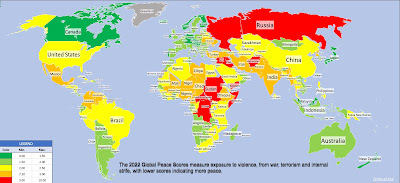 Source: Institute for Peace and Economics
Source: Institute for Peace and EconomicsNote that the peace scores were updated to reflect the Russian invasion of Ukraine and that the world's hotspots became more violent in 2021 and 2022. Third, corruption operates as an implicit tax, since business operating in corrupt parts of the world have to build in the associated costs and constraints. Transparency International measures a corruption score for countries, and the results of its 2021 iteration are mapped below:
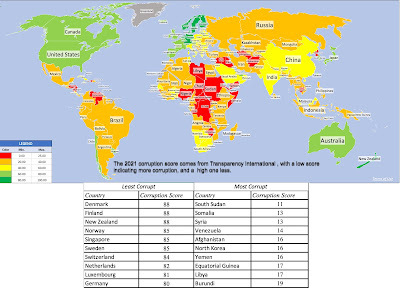 Source: Transparency InternationalNorthern Europe is the standout, when it comes to being free of corruption, but corruption clearly is a drag on businesses in Latin America, Africa and much of Asia. Finally, businesses are dependent on legal systems to enforce contracts and property rights, and legal protections vary widely across the world. I have mapped out an overall property rights score (based upon difference in physical, intellectual and legal property rights) below:
Source: Transparency InternationalNorthern Europe is the standout, when it comes to being free of corruption, but corruption clearly is a drag on businesses in Latin America, Africa and much of Asia. Finally, businesses are dependent on legal systems to enforce contracts and property rights, and legal protections vary widely across the world. I have mapped out an overall property rights score (based upon difference in physical, intellectual and legal property rights) below:
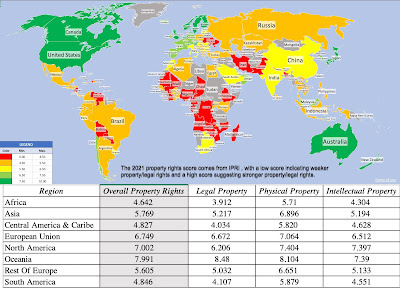 Source: International Property RightsLegal protections for businesses are strongest in Australia and North America and weakest in Africa and Latin America.
Source: International Property RightsLegal protections for businesses are strongest in Australia and North America and weakest in Africa and Latin America. While country risk has so many dimensions to it, there is correlation across the many dimensions, with corruption, poor legal protections, violence and political instability often moving in tandem. There are several services that attempt to estimate composite country risk scores, incorporating the multiple factors. One of my long-standing favorites is Political Risk Services, which measures a country risk score on a scale from 0 to 100, with lower scores indicating more risk and higher scores associated with safety:
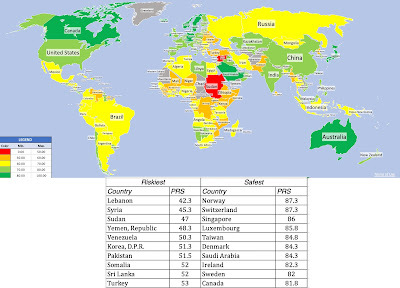 Source: The PRS Group
Source: The PRS GroupBased on the PRS composite risk measures, Africa remains the most risky region of the world for businesses to operate in, whereas Northern Europe, North America and Australia offer the most safety.
Country Risk: Default Risk and Ratings
For investors, the most direct measures of country risk come from measures of their capacity to default on their borrowings. At the start of 2022, for instance, there were several countries that were in technical default, on at least portions of their debt, and the Russian invasion of Ukraine has exacerbated sovereign default concerns around the world:
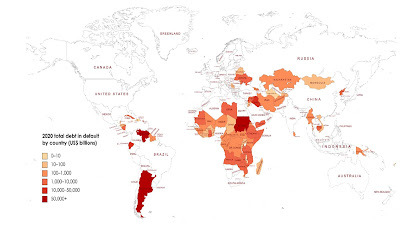 Source: Bank of England
Source: Bank of England
To measure sovereign default risk, ratings agencies (S&P, Moody’s, Fitch) estimate sovereign ratings for countries, designed to capture risk exposure in both local and foreign currency borrowing. The picture below reports on Moody’s ratings, as of June 30, 2022:
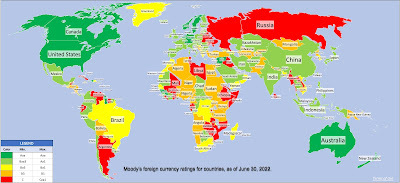 Source: Moody's
Note that this picture has been updated to incorporate Russia’s rating reassessment (downgraded to Ca in early April, before the rating was entirely withdrawn). I know that there are some of you, who distrust ratings agencies, arguing that they have regional and other biases and/or that they do not adjust ratings in a timely fashion. If you are in that group, the sovereign CDS market offers market-based and real-time measures of sovereign default risk, although for only 80 countries, and the map below reports the sovereign CDS spreads, as of June 30, 2022:
Source: Moody's
Note that this picture has been updated to incorporate Russia’s rating reassessment (downgraded to Ca in early April, before the rating was entirely withdrawn). I know that there are some of you, who distrust ratings agencies, arguing that they have regional and other biases and/or that they do not adjust ratings in a timely fashion. If you are in that group, the sovereign CDS market offers market-based and real-time measures of sovereign default risk, although for only 80 countries, and the map below reports the sovereign CDS spreads, as of June 30, 2022: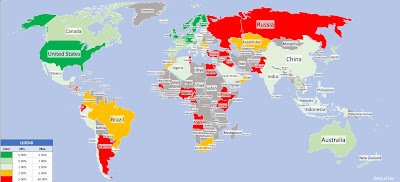 Source: Bloomberg
Source: BloombergComparing the sovereign CDS spread picture to the sovereign ratings picture, you can see the overlaps, with the ratings agencies and CDS market mostly in agreement.
Country Risk: Equity Risk
For equity investors, the price of risk is captured by the equity risk premium, and equity risk premiums will vary across countries. I use a template that starts with the implied equity risk premium that I compute for the S&P 500 and then adds on a country risk premium that is computed based upon the sovereign default spread (either from the CDS market or based upon a sovereign rating), to get equity risk premiums for countries:
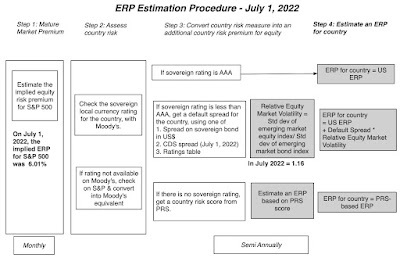 The equity risk premiums that result from this assessment are shown in the picture below, with a very rough attempt to break down countries geographically. (Please do not attach any political significance to my country groupings, or take them personally. I mean no disrespect to any country, and if you feel your country has been mis-grouped, I apologize.):
The equity risk premiums that result from this assessment are shown in the picture below, with a very rough attempt to break down countries geographically. (Please do not attach any political significance to my country groupings, or take them personally. I mean no disrespect to any country, and if you feel your country has been mis-grouped, I apologize.):
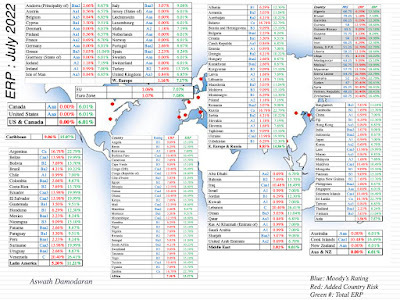 Source: Spreadsheet with country risk premium data (Damodaran Online)
Source: Spreadsheet with country risk premium data (Damodaran Online)
If you compare the numbers in this picture to the equivalent one that I reported at the start of the year, you can see the surge in risk premiums across the board, starting with a higher base premium (6.01%, up from 4.24%) for the US and higher spreads for country risk. Looking at individual countries, the graph below summarizes the countries that saw the biggest increases in equity risk premiums (on a percentage basis) over the six months (from Jan 1, 2022 - June 30, 2022):
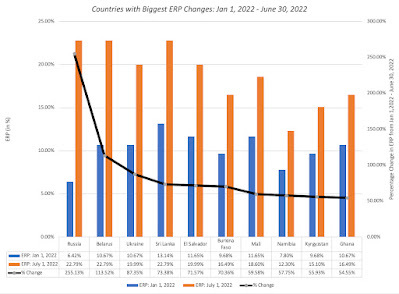 Not surprisingly, Russia and Ukraine make the list, with Russia's equity risk premium almost tripling and Ukraine's doubling over the period, but you can see the spillover effects into Belarus and Kyrgyzstan. There are three African countries that make the list (Namibia, Mali and Ghana), largely because of ratings downgrades, Sri Lanka's downgrade reflects the implosion of its political system and El Salvador's experiments with Bitcoin are not going well.
Not surprisingly, Russia and Ukraine make the list, with Russia's equity risk premium almost tripling and Ukraine's doubling over the period, but you can see the spillover effects into Belarus and Kyrgyzstan. There are three African countries that make the list (Namibia, Mali and Ghana), largely because of ratings downgrades, Sri Lanka's downgrade reflects the implosion of its political system and El Salvador's experiments with Bitcoin are not going well.Country Risk: Currency and Cost of Capital
As a final part to this post, to see the shifts in country risk that we have seen in 2022, let’s start with an assessment of risk free rates. In my last post, I noted that concerns about inflation have played a big role in pushing up the US ten-year treasury bond rate from 1.51% on Jan 1, 2022, to 3.02% on June 30, 2022. That increase in interest rates is not restricted to the US dollar, as local currency government bond rates have risen around the world. In the graph below, I use these government bond rates as a starting point to estimate riskfree rates in multiple currencies, with adjustments for default risk in governments, using the sovereign default spreads from the last section:
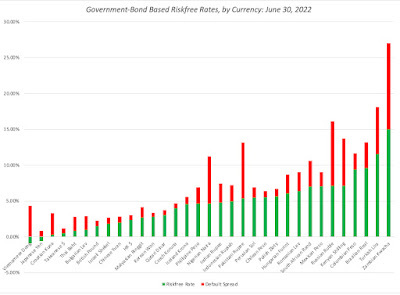
The biggest reason for differences in risk free rates across currencies is differences in expected inflation, with higher inflation currencies exhibiting higher riskfree rates. That said, the key to dealing with currency appropriately in valuation is to stay consistent, with cash flows and the discount rates incorporating the same expectations of inflation:
 In short, changing the currency that you use to value a company should not fundamentally change your assessment of that company’s value, and the reason that it often does in practice is because analysts are often sloppy in their treatment of currency, mixing growth rates in one currency with discount rates in another, and real with nominal numbers. As a general principle, to prevent double or miscounting inflation effects and risk, each input into discount rates carries a specific component, with the riskfree rate being the conveyor of expected inflation, the relative risk measure (beta for equity, bond rating for debt) measuring the business and leverage risk of the company and the equity risk premium/default spread reflecting the price of risk in markets.
In short, changing the currency that you use to value a company should not fundamentally change your assessment of that company’s value, and the reason that it often does in practice is because analysts are often sloppy in their treatment of currency, mixing growth rates in one currency with discount rates in another, and real with nominal numbers. As a general principle, to prevent double or miscounting inflation effects and risk, each input into discount rates carries a specific component, with the riskfree rate being the conveyor of expected inflation, the relative risk measure (beta for equity, bond rating for debt) measuring the business and leverage risk of the company and the equity risk premium/default spread reflecting the price of risk in markets.
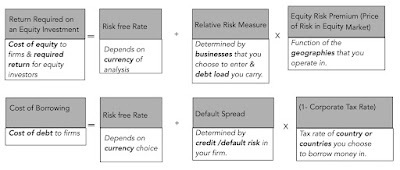
The combination of rising risk free rates (not just in US dollars, but also in other currencies) and surging risk premiums (default spreads and equity risk premiums) is pushing up corporate costs of capital. In the figure below, I graph the costs of capital for US and global firms, in US$ terms, on July 1, 2022:
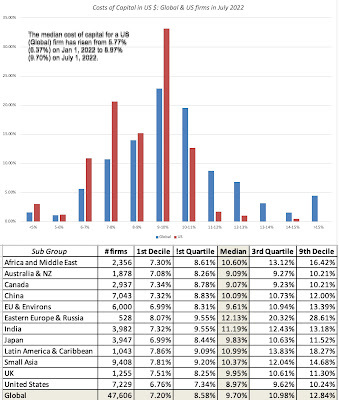 In January 2022, I had posted a similar histogram of costs of capital for global and US companies, reflecting risk free rates and risk premiums then, and the change, over the six months, has been extraordinary, with the median cost of capital for a US firm increasing from 5.77% to 8.97%, and for a global firm, from 6.37% to 9.70%. As I look across the many posts I have had this year on how inflation is changing market pricing and psychology, I find myself drawing on one of my favorite Bob Dylan lyrics, "the times, they are a'changin'". The biggest risk that we face, as we navigate our way through uncharted territory, is inertia, where we continue to do the things that have worked for the last decade, when we need to adapt and change.
In January 2022, I had posted a similar histogram of costs of capital for global and US companies, reflecting risk free rates and risk premiums then, and the change, over the six months, has been extraordinary, with the median cost of capital for a US firm increasing from 5.77% to 8.97%, and for a global firm, from 6.37% to 9.70%. As I look across the many posts I have had this year on how inflation is changing market pricing and psychology, I find myself drawing on one of my favorite Bob Dylan lyrics, "the times, they are a'changin'". The biggest risk that we face, as we navigate our way through uncharted territory, is inertia, where we continue to do the things that have worked for the last decade, when we need to adapt and change. YouTube Video
PaperCountry Risk: Determinants, Measures and Implications: The 2022 Edition (Eighth annual update)DatasetsCorruption, Violence and Legal Rights, by CountryDefault spreads and Equity Risk Premiums, by country
July 1, 2022
Risk Capital and Markets: A Temporary Retreat or Long Term Pull Back?
As inflation has taken center stage, markets have gone into retreat globally, and across asset classes. In 2022, as bond rates have risen, stock prices have fallen, and crypto has imploded, even true believers are questioning what the bottom for markets might be, and when we will get there. While it is easy to call the market movement in 2022 a correction and to argue that it is overdue, it is facile, and it fails to address the question of why it is happening now, and whether the correction is overdone or has more to go. In this post, I will argue that almost everything that we are observing in markets, across asset classes, can be explained by a pull back on risk capital, and that understanding the magnitude of the pull back, and putting in historical perspective, is key to gauging what is coming next.
Risk Capital: What is it?
To put risk capital in perspective, it is best to start with a definition of risk that is comprehensive and all-inclusive, and that is to think of risk as a combination of danger (downside) and opportunity (upside) and to consider how investments vary in terms of exposure to both. In every asset class, there is a range of investment choices, with some being safer (or even guaranteed) and others being riskier.
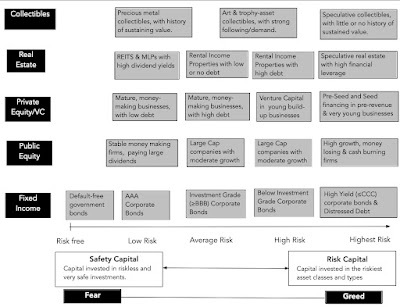
Risk capital is the portion of capital that is invested in the riskiest segments of each market and safety capital is that portion that finds its way to the safest segments in each market.
While risk and safety capital approach the market from opposite ends in the risk spectrum, one (safety capital) being driven by fear and the other (risk capital), by greed, they need to not only co-exist, but be in balance, for the market to be healthy. When to two are not in balance, these imbalances can have profound and often unhealthy effects not just of markets, but also on the overall economy. At the extremes, when risk capital is absent and everyone seeks safety, the economy and markets will atrophy, as businesses and investors will stay away from risky ventures, and when risk capital is too easy and accessible, risky asset prices will soar, and the economy will see too much growth in its riskiest segments, often at the expense of more stable (and still necessary) businesses.
Risk Capital's Ebbs and Flows
It is a common misconception that the risk-takers supply risk capital (risk takers) and that the investors who invest for safety draw from different investor pools, and that these pools remain unchanged over time. While investor risk aversion clearly does play a role in whether investors are drawn to invest in risk or safety capital, it obscures two realities:
Variation within an investor's portfolio: Many investors, including even the most risk averse, may and often do set aside a portion of their portfolios for riskier investments, drawn by the higher expected returns on those investments. For some investors, this set aside will be the portion that they can afford to lose, without affecting their life styles in any material way. For others, it can be the portion of their capital with the longest time horizon (pension fund savings or 401Ks, if you are a young investor, for example), where they believe that any losses on risk capital can be made up over time. For still others, it is that segment of their portfolios that they treat las long shot gambles, hoping for a disproportionately large payoff, if they are lucky. The amount that is put into the risk capital portion will vary with investor risk aversion, with more risk averse investors putting less or even nothing into the riskiest assets, and less risk averse investors putting in more.Variation across time: The amount that investors are willing to put into risk capital, or conversely redirect to safety capital, will change over time, with several factors playing a role in determining whether risk capital will be plentiful or scarce. The first is market momentum, since more money will be put into the riskiest asset classes, when markets are rising, because investors who benefit from these rising markets will have more capital that they are willing to risk. The second is the the health and stability of the economy, since investors with secure jobs and rising paychecks are more willing to take risks.There are two macro factors that will come into play, and both are in play in markets today. The first is the return that can be earned on guaranteed investments, i.e., US treasury bills and bonds, for instance, if you are a investor in US dollar, since it is a measure of what someone who takes no or very low risk can expect to earn. When treasury rates are low or close to zero, refusing to take risk will result in returns that are very low or close to zero as well, thus inducing investors to expose themselves to more risk than they would have taken in higher interest rate regimes. The second is inflation, which reduces the nominal return you make on all your investments, and the effects of rising inflation on risk capital are complex. As expected inflation rises, you are likely to see higher interest rates, and as we noted above, that may induce investors to cut back on risk taking and focus on earning enough to cover the ravages of inflation. As uncertainty about inflation rises, you will see reallocation of investment across asset classes, with real assets gaining when unexpected inflation is positive (actual inflation is higher than expected), and financial assets benefiting when unexpected inflation is negative (actual inflation is less than expected).
And Consequences
If you are wondering why you should care about risk capital's ebbs and flows, it is because you will feel its effects in almost everything you do in investing and business.
Risk Premiums: The risk premiums that you observe in every risky asset market are a function of how much risk capital there is in play, with risk premiums going up when risk capital becomes scarcer and down, when risk capital is more plentiful. In the bond and loan market, access to risk capital will determine default spreads on bonds, with lower rated bonds feeling the pain more intensely when risk capital is withdrawn or moves to the side lines. Not only will default spreads widen more for lower-rated bonds, but there will be less bond issuances by riskier companies. In the equity market, the equity risk premium is the price of risk, and its movements will track shifts in risk capital, increasing as risk capital becomes scarcer. Price and Value Gaps: As those of you who read this blog know well, I draw a contrast between value and price, with the former driven by fundamentals (cash flows, growth and risk) and the latter by mood, momentum and liquidity. The value and price processes can yield different numbers for the same company, and the two numbers can diverge for long periods, with convergence not guaranteed but likely over long periods.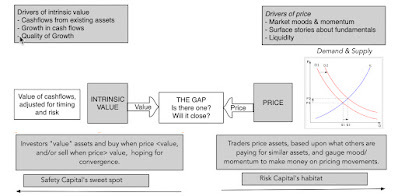
I argue that investors play the value game, buying investments when the price is less than the value and hoping for convergence, and that traders play the pricing game, buying and selling on market momentum, rather than fundamentals. At the risk of generalizing, safety capital, with its focus on earnings and cash flows now, is more likely to focus on fundamentals, and play the investor game, whereas risk capital, drawn by the need to make high returns quickly, is more likely to play the trading game. Thus, when risk capital is plentiful, you are more likely to see the pricing game overwhelm the value game, with prices often rising well above value, and more so for the riskiest segments of every asset class. A pull back in risk capital is often the catalyst for corrections, where price not only converges back on value, but often overshoots in the other direction (creating under valuations). It behooves both investors and traders to therefore track movements in risk capital, since it is will determine when long term bets on value will pay off for the former, and the timing of entry into and exit from markets for the latter.Corporate Life Cycle: The ebbs and flows of risk capital have consequences for all businesses, but the effects will vary widely across companies, depending on where they are in the life cycle. Using another one of my favorite structures, the corporate life cycle, you can see the consequences of expanding and shrinking risk capital, through the lens of free cash flows (and how they vary across the life cycle).
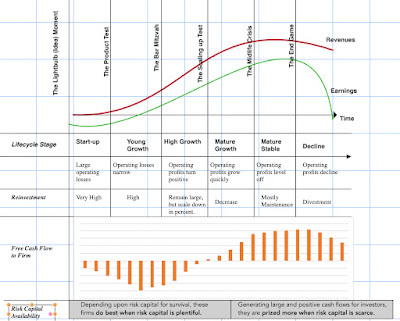
Early in the corporate life cycle, young companies have negative free cash flows, driven by losses on operations and investments for future growth, making them dependent on risk capital for survival and growth. As companies mature, their cash flows first become self sustaining first, as operating cash flows cover investments, and then turn large and positive, making them not only less dependent on risk capital for survival but also more valued in an environment where safety capital is dominant. Put simply, as risk capital becomes scarcer, young companies, especially those that are money-losing and with negative cash flows, will see bigger pricing markdowns and more failures than more mature companies.
Risk Capital: Historical Perspective
How do you track the availability and access to risk capital over time? There are three proxies that I will use, and while each has its limitations, read together, they can provide a fuller measure of the ebbs and flows of risk capital. The first is funds invested by venture capitalists, with a breakdown further into types, from pre-seed and seed financing to very young companies to capital provided to more young companies with more established business models, as a prelude to exit (acquisition or IPO). The second is the trend line in initial public offerings (number and value raised), since companies are more likely to go public and be able to raise more capital in issue proceeds, when risk capital is plentiful. The third is original bond issuances by the riskiest companies (below investment grade and high yield), since these issuances are more likely to have a friendly reception when risk capital is easily available than when it is not.
Let’s start with venture capital, the typical source of capital for start ups and young companies for decades in the United States, and more recently, in the rest of the world. In the graph below, I trace out total venture capital raised, by year, between 1995 and 2021, in the US:
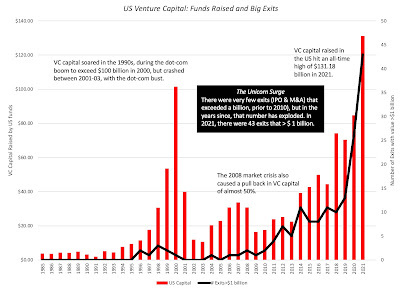 Source: NVCA YearbooksThe dot-com boom in the 1990s created a surge in venture capital raised and invested, with venture capital raised peaking at more than $100 billion in 2000, before collapsing as the that bubble burst. The 2008 banking and market crisis caused a drop of almost 50% in 2009, and it took the market almost five years to return to pre-crisis levels. In the just-concluded decade, from 2011 to 2020, the amount raised and invested by venture capitalists has soared, and almost doubled again in 2021, from 2020 levels, with venture capital raised in 2021 reaching an all-time high of $131 billion, surpassing the 2000 dot-com boom levels, albeit in nominal terms. Along the way, exits from past venture capital investments, either in IPOs or in M&A, have become more lucrative for the most successful companies, with 43 exits that exceeded a billion (the unicorn status) in 2021.
Source: NVCA YearbooksThe dot-com boom in the 1990s created a surge in venture capital raised and invested, with venture capital raised peaking at more than $100 billion in 2000, before collapsing as the that bubble burst. The 2008 banking and market crisis caused a drop of almost 50% in 2009, and it took the market almost five years to return to pre-crisis levels. In the just-concluded decade, from 2011 to 2020, the amount raised and invested by venture capitalists has soared, and almost doubled again in 2021, from 2020 levels, with venture capital raised in 2021 reaching an all-time high of $131 billion, surpassing the 2000 dot-com boom levels, albeit in nominal terms. Along the way, exits from past venture capital investments, either in IPOs or in M&A, have become more lucrative for the most successful companies, with 43 exits that exceeded a billion (the unicorn status) in 2021. If success in venture capital comes from exiting investments at a higher pricing, initial public offerings represent the most lucrative route, and tracking the number of initial public offerings over time provides a window on the ebbs and flows of risk capital, over long periods. Using data made public by Jay Ritter on IPOs, I track the number of IPO and dollar proceeds from offerings in the graph below from 1980 to 2021:
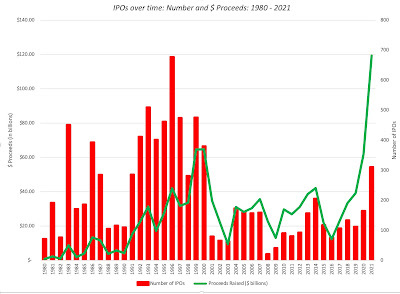 Source: Jay RitterAs you can see, IPOs go through hot periods (when issuances surge) and cold ones (when there are relatively few listed), with much of the last decade representing hot periods and 2000/01 and 2008/09 representing periods when there were hardly any offerings. While the number of IPOs in 2021 is still below the peak dot-com years, the proceeds from IPOs has surged to an all-time high during the year.
Source: Jay RitterAs you can see, IPOs go through hot periods (when issuances surge) and cold ones (when there are relatively few listed), with much of the last decade representing hot periods and 2000/01 and 2008/09 representing periods when there were hardly any offerings. While the number of IPOs in 2021 is still below the peak dot-com years, the proceeds from IPOs has surged to an all-time high during the year.In the final graph, I look at corporate bond offerings, broken down into investment grade and high yield, by year, from 1996 to 2021:
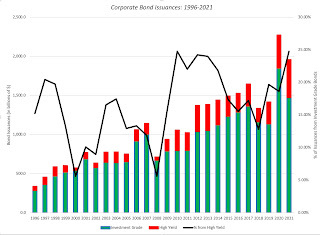 Source: SIFMA
Source: SIFMAHere again, you see a familiar pattern, with the percentage of high-yield bond issuances tracking the availability of risk capital. As with IPOs, you see big dips in 2000-01and 2008-09, reflecting market corrections and crises, and a period of easy access to risk capital in the last decade. Again, the percentage of corporate bond issuances hit an all-time high in 2021, representing more than a quarter of all bond issuances. In sum, all three proxies for risk capital show the same patterns over time, pulling back and surging during the same time periods, and with all three proxies, it is clear that 2021 was a boom year.
An Update
The last two and a half years may not represent much time on a historical scale, but the period has packed in enough surprises to make it feel like we have aged a decade. We started 2020 with a pandemic that altered our personal, work and financial lives, and in 2022, at least in North America and Europe, we have seen inflation reach levels that we have not seen for decades. Looking at the 30 months through the lens of risk capital can help us understand not only the journey that markets have gone through to get where they are today, but also perhaps decipher where they may go next. In the graph below, I look at venture capital, IPOs and high yield bond issuances over the last two and a half years:
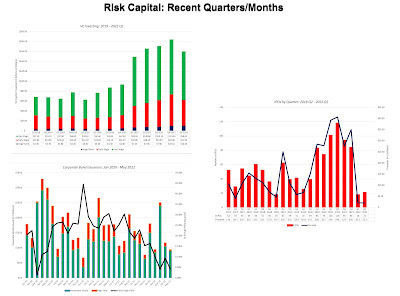
The first thing to note is that there was a pullback on all three measures in the first quarter of 2020, as COVID put economies into deep freeze and rolled markets. The big story, related to COVID, is that risk capital not only did not stay on the side lines for long but came surging back to levels that exceeded pre-COVID numbers, with all three measures hitting all-time highs in 2021. In a post in late 2020, I argued that it was the resilience of risk capital that explained why markets recovered so quickly that year, even as the global economy struggled, that year, and pointed to three explanatory factors. The first was the perception that the COVID shut-down was temporary, and that economies would come back quickly, once the immediate threat from the virus passed. The second was the decline in interest rates across the globe, with rates in developed market currencies (US $, Euro, Japanese Yen etc.) moving towards zero, increasing the costs of staying on the sidelines. The third was a change in investor composition, with a shift from institutional to individual investor market leadership, and increased globalization.
The first half of 2022 has been a trying period for markets, and as inflation has risen, it is having an effect on the availability of and access to risk capital. There has been a pullback in all three proxies for risk capital, albeit smaller in venture capital, than in IPOs and in high-yield bond issuances in the first few months of 2022. That pullback has had its consequences, with equity risk premiums rising around the world. In the graph below, I have updated the equity risk premium for the S&P 500 through the start of July 2022:
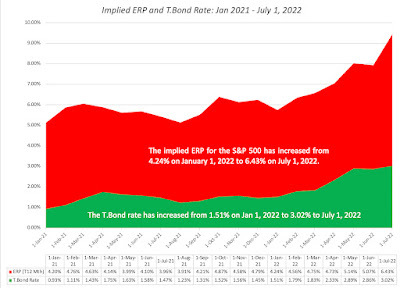 Spreadsheet for implied ERP
Spreadsheet for implied ERPThe chart reveals how unsettling this year has been for equity investors, in the United States. Not only has the implied ERP surged to 6.43% on June 23, 2022, from 4.24% on January 1, 2022, but stocks are now being priced to earn 9.45% annually, up from the 5.75% at the start of the year. (The jump in ERP may be over stated, since the forward earnings estimates for the index, from analysts, does not seem to be showing any upcoming pain from an expected recession. )
As inflation and recession fears have mounted, equity markets are down significantly around the world, but the drop in pricing has been greatest in the riskiest segments of the market. In the table below, I look at the price change in the first six months of 2022 for global stocks, broken down by quintiles, into net profit margin and revenue growth classes:
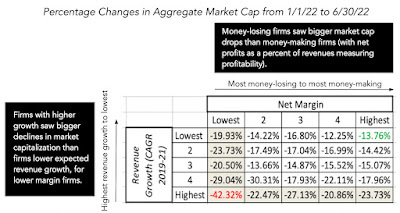 Source for raw data: S&P Cap IQ
Source for raw data: S&P Cap IQNote that high growth, negative earnings companies have fared much worse, in general, during the 2022 downturn, than more mature, money-making companies. The fear factor that is tilting the balance back to safety capital from risk capital has also had clear consequences in the speculative collectibles space, with cryptos bearing the brunt of the punishment. Finally, there are markdowns coming to private company holdings, both in the hands of venture capitalists, and public market investors (including mutual funds that have been drawn into this space and public companies like Softbank).
The big question that we all face, as we look towards the second half of the year, is whether the pullback in risk capital is temporary, as it was in 2020, or whether it is more long term, as it was after the dot-com bust in 2000 and the market crisis in 2008. If it is the former, there is hope of not just a recovery, but a strong rebound in risky asset prices, and if it is the latter, stocks may stabilize, but the riskiest assets will see depressed prices for much longer. I don't have a crystal ball or any special macro forecasting abilities, but if I had to guess, it would be that it is the latter. Unlike a virus, where a vaccine may provide at least the semblance of a quick cure (real or imagined), inflation, once unleashed, has no quick fix. Moreover, now that inflation has reared its head, neither central banks nor governments can provide the boosts that they were able to in 2020 and may even have to take actions that make things worse, rather than better, for risk capital. Finally, at the risk of sounding callous, I do think that a return of fear and a longer term pullback in risk capital is healthy for markets and the economy, since risk capital providers, spoiled by a decade or more of easy returns, have become lazy and sloppy in their pricing and trading decisions, and have, in the process, skewed capital allocation in the economy. If a long-term slowdown is in the cards, it is almost certain that the investment strategies that delivered high returns in the last decade will no longer work in this new environment, and that old lessons, dismissed as outdated just a few years go, may need to be relearned.
YouTube Video
May 20, 2022
A Follow up on Inflation: The Disparate Effects on Company Values!
In my last post, I discussed how inflation's return has changed the calculus for investors, looking at how inflation affects returns on different asset classes, and tracing out the consequences for equity values, in the aggregate. In general, higher and more volatile inflation has negative effects on all financial assets, from stocks to corporate bonds to treasury bonds, and neutral to positive effects on gold, collectibles and real assets. That said, the impact of inflation on individual company values can vary widely, with a few companies benefiting, some affected only lightly, and other companies being affected more adversely, by higher than expected inflation. In an environment where finding inflation hedges has become the first priority for most investors, the search is on for companies that are less exposed to high and rising inflation. The conventional wisdom, based largely on investor experiences from the 1970s, is that commodity companies and firms with pricing power are the best ones to hold, if you fear inflation, but is that true, and even if it is true, why is it so? To answer these questions, I will return to basics and try to trace the effects of inflation on the drivers of value, with the intent of finding the characteristics of stocks with better inflation-hedging properties.
Inflation and Value
When in doubt about how any action or information plays out in value, I find it useful to go back to value basics, and trace out the effects of that action/information on value drivers. Following that rule book, I looked at the effects of inflation on the levers that determines value, in the graph below:
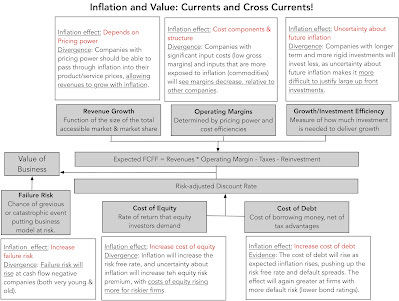
Put simply, the effects of inflation on firm value boil down to the impact inflation has on expected cash flows/growth and risk. At the risk of restating what is already in the graph above, the factors that will play out in determining the end impact on inflation on value are in the table below:
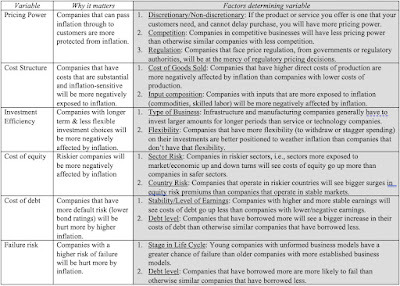
If you were seeking out a company that would operate as an inflation hedge, you would want it to have pricing power on the products and services that it sells, with low input costs, and operating in a business where investments are short term and reversible. On the risk front, you would like the company to have a large and stable earnings stream and a light debt load.
Looking BackThere are lessons that can be learned by looking at the past, about how inflation affects different groupings of companies, though there is the danger of over extrapolation. In this section, I look first at how classes of stocks have done over the decades, and relating that performance to inflation (expected and unexpected). I then examine how equities have performed in the less than five months of 2022, where inflation has returned to the front pages.
Historical Data: 1930-2019To see how this framework works in practice, let's start by looking at the performance of US stocks, across the decades, and look at the returns on stocks, broadly categorized based on market capitalization and price to book ratios. The former is short hand for the small cap premium and the latter is the proxy for the value factor in returns.
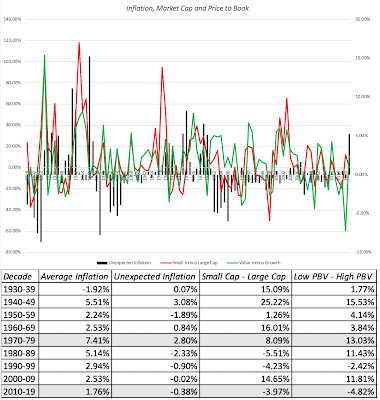 The distinction that I made between expected and unexpected inflation comes into play in this table. It is unexpected inflation that seems to have a large impact on the behavior of small cap stocks, outperforming in decades where inflation was higher than expected (1940-49, 196069, 1970-79) and underperforming in decades with lower than expected inflation (1990-99, 2010-19). The value effect, measured as the difference between low price to book and high price to book stocks was highest in the 1970s, when both actual and unexpected inflation were high, but remained resilient in the 1980s, when inflation stayed high, but came in under expectations.
The distinction that I made between expected and unexpected inflation comes into play in this table. It is unexpected inflation that seems to have a large impact on the behavior of small cap stocks, outperforming in decades where inflation was higher than expected (1940-49, 196069, 1970-79) and underperforming in decades with lower than expected inflation (1990-99, 2010-19). The value effect, measured as the difference between low price to book and high price to book stocks was highest in the 1970s, when both actual and unexpected inflation were high, but remained resilient in the 1980s, when inflation stayed high, but came in under expectations.
The 2022 Experience As the focus has shifted back to inflation in the last five months, it is worth looking at performance across US stocks, broken down by different categorizations, to see whether the patterns of the past are showing up in today's markets.. For starters, let's look at the how the damage done by inflation on stocks varies across sectors, looking at the 2022 broken down in three slices, the returns in the first quarter of 2022 (when Russia competed with inflation for market attention), the period from April 1 - May 19, 2022 (when inflation was the dominant story) and the entire year to date.
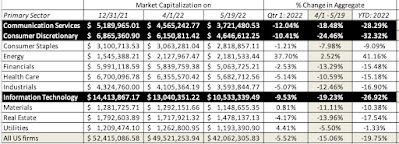
In 2022, the collective market capitalization of all US firms has dropped by 19.75%, with the bulk of the drop occurring after April 1, 2022. During the period (April 1- May 19, 2022), the three worst performing sectors (highlighted) were technology, consumer discretionary and communication services, and the best performing sectors were energy (no surprise, given the rise in oil prices) and utilities, old standbys for investors during tumultuous periods.
To check to see if the outperformance of small cap and low price to book ratios that we saw in the 1970s is being replicated in 2022, I broke companies down by decile (based on market cap and price to book at the start of 2022), and looked at changes in aggregate value in 2022:
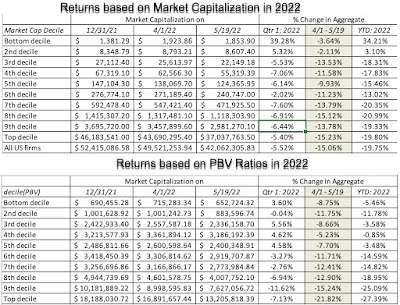
As in the 1970s, the small cap premium seems to have returned with a vengeance, as small cap stocks have outperformed large caps in 2022, and the lowest price to book stocks have done less badly than high price to book stocks. To examine the interaction and stock price performance in 2022, I looked at the aggregate returns on firms classified into deciles based upon both equity risk (betas) and default risk (with bond ratings):
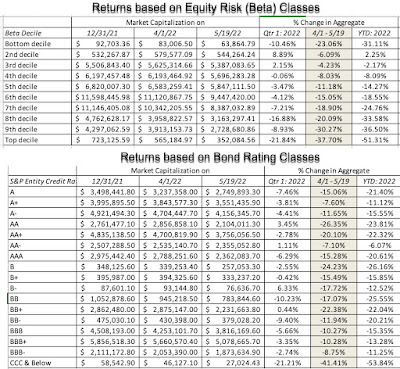 The link between equity risk and stock returns support the hypothesis that firms that are riskier are more affected by inflation, with one exception: the stocks with the lowest betas have also done badly in 2022. On bond ratings, there is no discernible link between ratings and returns, until you get to the lowest rated bonds (CCC & below). In a final assessment, I break down companies based upon operating cash flows (EBITDA as a percent of enterprise value) and dividend yield (dividends as a percent of market capitalization).
The link between equity risk and stock returns support the hypothesis that firms that are riskier are more affected by inflation, with one exception: the stocks with the lowest betas have also done badly in 2022. On bond ratings, there is no discernible link between ratings and returns, until you get to the lowest rated bonds (CCC & below). In a final assessment, I break down companies based upon operating cash flows (EBITDA as a percent of enterprise value) and dividend yield (dividends as a percent of market capitalization).
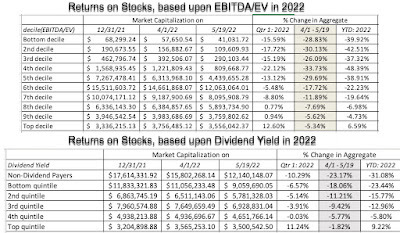 Companies that generate more cash flows from their operations and return more of that cash flow in dividends to stockholders have clearly held their value better than companies with low or negative cash flows that pay no dividends, in 2022. Looking at these results, value investors will undoubtedly find vindication for their beliefs that this is a correction long over due, i.e., a return to normalcy where safe stocks in boring sectors that pay high dividends deliver excess returns. I do think that given how consistently growth stocks have been beating value stocks for the last decade, a correction was in order, but I believe it is way too early to proclaim the return of old fashioned value investing.
Companies that generate more cash flows from their operations and return more of that cash flow in dividends to stockholders have clearly held their value better than companies with low or negative cash flows that pay no dividends, in 2022. Looking at these results, value investors will undoubtedly find vindication for their beliefs that this is a correction long over due, i.e., a return to normalcy where safe stocks in boring sectors that pay high dividends deliver excess returns. I do think that given how consistently growth stocks have been beating value stocks for the last decade, a correction was in order, but I believe it is way too early to proclaim the return of old fashioned value investing. Bottom LineThis has been a painful year for investors in US equities, but the pain has not been evenly spread across investors. Portfolios that are over weighted in risky, money losing companies have been hurt more than portfolios that are more weighted towards companies with less debt and more positive cash flows. Even within some of the worst performing sectors, such as technology, breaking companies down, based upon earnings and cash flows, there is a clear advantage to holding money making, older tech companies than money losing, young tech companies:
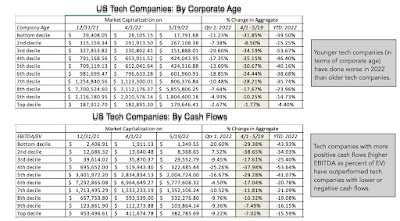 The question of whether these trends will continue to apply for the rest of the year cannot be answered without taking a stand on inflation, and the effects that fighting it will create for the economy. If you believe that there is more surprises to come on the inflation front, and that a recession is not only imminent, but likely to be steep, the returns in the first five months of 2022 will be a precursor to more of the same, for the rest of the year. If you believe that markets have mostly or fully adjusted to higher inflation, betting on a continuation of the small cap and value outperformance to continue is dangerous. To the extent that there may be other countries where inflation is not the clear and present danger that it is in the United States, investing in equities in those countries will offer better risk and return tradeoffs.As I noted in my last post, once the inflation genie is out of the bottle, it tends to drive every other topic out of market conversations, and become the driving force for everything from asset allocation to stock selection.
The question of whether these trends will continue to apply for the rest of the year cannot be answered without taking a stand on inflation, and the effects that fighting it will create for the economy. If you believe that there is more surprises to come on the inflation front, and that a recession is not only imminent, but likely to be steep, the returns in the first five months of 2022 will be a precursor to more of the same, for the rest of the year. If you believe that markets have mostly or fully adjusted to higher inflation, betting on a continuation of the small cap and value outperformance to continue is dangerous. To the extent that there may be other countries where inflation is not the clear and present danger that it is in the United States, investing in equities in those countries will offer better risk and return tradeoffs.As I noted in my last post, once the inflation genie is out of the bottle, it tends to drive every other topic out of market conversations, and become the driving force for everything from asset allocation to stock selection. YouTube Video
Inflation Posts (in 2022)Data Update 3 for 2022: Inflation and its Ripple Effects (January 27, 2022)In Search of a Steady State: Inflation, Interest Rates and Value (May 6, 2022)A Follow up on Inflation: The Disparate Effects on Company Values (May 20, 2022)
May 6, 2022
In Search of a Steady State: Inflation, Interest Rates and Value
The nature of markets is that they are never quite settled, as investors recalibrate expectations constantly and reset prices. In most time periods, those recalibrations and resets tend to be small and in both directions, resulting in the ups and downs that pass for normal volatility. Clearly, we are not in one of those time periods, as markets approach bipolar territory, with big moves up and down. The good news is that the culprit behind the volatility is easy to identify, and it is inflation, but the bad news is that inflation remains the most unpredictable of all macroeconomic factors to factor into stock prices and value. In this post, I will look at where we stand on inflation expectations, and the different paths we can end up on, ranging from potentially catastrophic to mostly benign.
Inflation: The Full Story
I wrote my first post on this blog in 2008, and inflation merited barely a mention until 2020, though it is an integral component of investing and valuation. Since 2020, though, inflation has become a key story line in almost every post that I write about the overall market, and I have had multiple posts just on the topic. To see why inflation has become so newsworthy, take a look at the chart below, where I graph inflation from 1950 to 2022, in the United States:
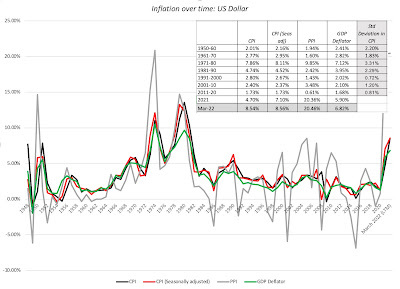 Download data
Download data
While I report multiple measures of inflation, from the consumer price index (adjusted and unadjusted) to the producer price index, to the price deflator used in the GDP, they all tell the same story. We have had a long stretch of low and stable inflation, and that is especially true since the 2008 crisis. In fact, the average inflation rate in the 2011-20 decade was the lowest of the seven decades that I cover in this chart. Just as important, though, is the fact that variation in inflation, from year to year, was lower in 2011-2020 in every other decade, other than 1991-2000. It reinforces a point I made in my inflation post last year, where I argued that to understand inflation's impact on asset values, you have to break it down into its expected and unexpected components, with the former showing up in the expected returns you demand on investments, and the latter playing out as a risk factor.
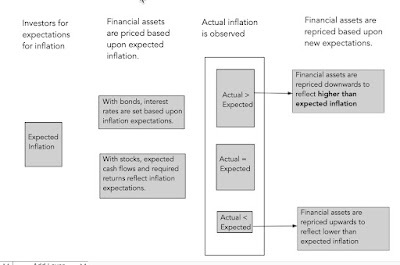
Investors who are old enough to remember the 1970s point to it as a decade of high inflation, but that is only with the benefit of hindsight. At the start of that decade, investors had no reason to believe that they were heading into a decade of higher inflation, and initial signs of price increases were attributed to temporary factors (with OPEC being a convenient target). In fact, expected inflation lagged actual inflation through much of the decade, and the damage done to financial asset returns that decade came as much from actual inflation being higher than expected inflation, period after period, as from higher inflation.
It is precisely because we have been spoiled by a decade of low and stable inflation that the inflation numbers in 2021 and 2022 came as such a surprise to economists, investors and even the Fed. Early on, the inflation surge was explained away by the reopening of the economy, after the COVID shutdown, and then by stressed supply chains, and expectations about future inflation stayed low. However, as reported inflation has remained stubbornly high, and neither COVID nor supply chains provided sufficient rationale, market expectations of inflation have started to go up. I capture this shift using two measures of expected inflation, the first coming from the University of Michigan's surveys of consumer expectations of inflation for the future and the latter from the US Treasury market, as the difference between the ten-year treasury bond and the ten-year inflation-protected treasury bond (TIPs) rates:
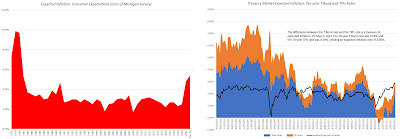
Consumer expectations of inflation reached 5.40% in March 2022, hitting levels not seen since the early 1980s. While the market-implied expected inflation rate has also climbed to a ten-year high of 2.85%, it is clearly lower than the consumer survey expectation. There are three possible explanations for the divergence:Short term versus Long term: The consumer survey extracts an expectation of inflation in the near term, whereas the treasury markets are providing a longer term perspective, since I am using ten-year rates to derive the market-implied inflation.Consumers are over adjusting: The big inflation surges have happened in gasoline, food and housing, all items that consumers use on a continuous basis, and it is possible that they are over reacting and adjusting expected inflation up too much, as a consequence.Markets are under adjusting: Alternatively, it is possible that it is consumers who are being realistic, and it is that the bond markets which are under adjusting to higher inflation, partly because many investors have operated only in a low and steady inflation environment, and partly because some of these investors have a belief that the Fed has super powers when it comes to setting interest rates and determining inflation.I have always argued that the notion of the Fed as this all-powerful entity that sets rates, determines economic growth and keeps inflation in check is a myth, and a very dangerous one at that, since it gives license to policy makers and investors to behave rashly, expecting a safety net to protect them from their mistakes.
Economic Consequences
As inflation, actual and expected, has made a return, it is not surprising that the ripple effects are being felt across the economy, with the ripples sometimes resembling tidal waves. The most direct effects have been on interest rates, where we have seen rates rise quickly, and to levels not seen in years. In the chart below, I look at how the treasury curve has shifted in the recent periods:
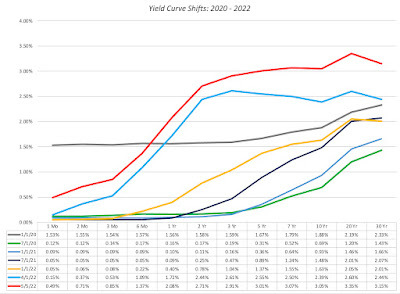
To provide a sense of how much rates have changed just in 2022, compare the yield curve on January 1, 2022 to the one on May 5, 2022. On January 1, 2022, the yields on the very short end of the maturity spectrum (1-6 month treasuries) were close to zero, the ten-year treasury bond rate was 1.51% and the long end of the yield curve had an upward slope. On May 5, 2022, the treasury yields for the short end had risen, with the 1-month rate reach 0.50%, the ten-year treasury bond rate had breached 3% and the term structure had leveled out for the long end of the spectrum (with the 2-year yield moving towards the 10-year yield, which in turn was close to the 20-year and 30-year yields). Of course, the "Fed did it" crowd will argue that this is all Jerome Powell's doing, an indication of how little they understand about both what rates the Fed does control (the Fed Funds rate is at the very shortest end of the spectrum, and it is not a trading rate) and how willing they are to ignore the data. If you were to graph out when the Fed woke up from its inflation-denial and when treasury rates started rising, it seems clear that it was the treasury market that is causing the Fed to act, rather than the other way around. As treasury rates have risen, markets also seem to have been more wary about risk, and how it is being priced. In the chart below, I start with the default spreads in the corporate bond market and you can see the increase in spreads that have occurred just over the course of 2022:
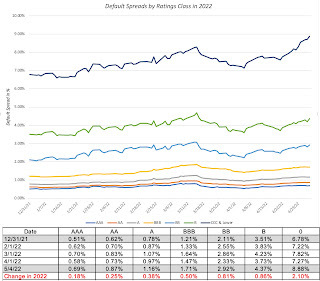
Default spreads have risen across every ratings class, but more so for lowly-rated bonds than for bonds with higher ratings. Here again, there are some who would attribute this to the Russia-Ukraine conflict, but that would miss the fact that bulk of the surge in spreads happened before February 23, 2022, when the conflict started. In the equity market, I capture the price of risk with a forward-looking estimate of expected returns on stocks, computed from the level of stock prices and expected future cash flows, and I graph both the expected return and the implied equity risk premium (from netting out the risk free rate) in the graph below:
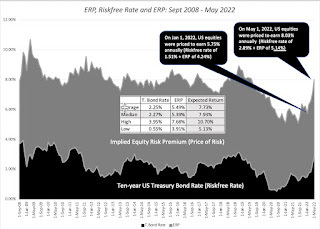 Implied ERP spreadsheet
Implied ERP spreadsheet
In equity markets, the shift in expected returns has been significant, perhaps even dramatic, as the expected return on stocks, which started 2022 at 5.75%, has moved above 8% for the first time since May 2019, with some of that shift coming from a higher treasury bond rate (1.51% to 2.89%) and some of it coming from a higher equity risk premium (4.24% to 5.14%).
As the inflation bogeyman returns, the worries of what may need to happen to the economy to bring inflation back under control have also mounted. Almost every economic forecasting service has increased its assessed probability for a recession, with variations on depth and length. In a note published in mid-April, Larry Summers and Alex Domash go as far as to put the likelihood of a recession at 100%, based upon a joint indicator, i.e., that a combination of inflation > 5% and unemployment<4% has always led to a recession within 12 to 24 months, using quarterly data from the 1950s to today. While I remain a skeptic about historic rules of thumb (downward sloping yield curve, for example) to make predictive statements about future economic growth, I think that we can state categorically that there is a greater chance of an economic slowdown now than just a few weeks ago.
Investment Consequences
As the storm clouds of higher inflation and interest rates, in conjunction with slower or even negative economic growth, gather, it should come as no surprise that equity markets are struggling to find their footing. At the close of trading on May 5, 2022, the S&P 500 stood at 4147, down 13.3% from the start of the year value, accompanied by increased volatility. To the question of whether to sell, hold on or buy in the face of weakness, the answer will depend on your macro assessments of the following:
Steady State Interest Rate: As noted in the last section, the ten-year bond rate has doubled this year, an uncommonly large move for US treasuries, and there are three possibilities for the future. The first is that the bulk of the move in rates is behind us, and that treasury rates now reflect updated expectations of inflation. The second is that, like the 1970s, we will play catch up with inflation, and that rates will continue to move up, until expectations on inflation become more realistic. The third is that inflation is either transient, and will revert back to the lows we saw last decade, or that the economy will go into a recession and act as a natural break on inflation and interest rates. Note that in all three cases, it is not the Fed that is driving rates, but what is happening to inflation.Equity Risk Premium Path: The equity risk premium of 5.24%, estimated at the start of May 2022, is at the high end of historical equity risk premiums, but we have seen higher premiums, either in crises (end of 2008, first quarter of 2020) or when inflation has been high (the late 1970s). I think that what happens to equity risk premiums for the rest of the year will largely depend on inflation numbers, with high and volatile inflation continuing to push up the premium, and steadying and dropping inflation having the opposite effect.Earnings Estimates: The strength of the economy has been a big contributor to boosting actual and expected earnings on companies in the last two years, and these higher earnings have translated into more cash returned in dividends and buybacks. The earnings estimates for the S&P 500 companies from analysts, at the start of May 2022, reflect that strength and there seems to have been no adjustment downwards for a recession possibility. That may either reflect the fact that equity analysts are not among those who expect a recession (or expect only a very mild one, with little impact on earnings) or the possibility that there may be a lag in the process between the economy weakening and analysts adjusting expected earnings.To see how these three forces play out, consider what I would term the status quo scenario, where you assume that today's treasury bond rate (3%) is the steady state, that earnings estimates will largely be delivered and that the equity risk premium will stabilize around current levels: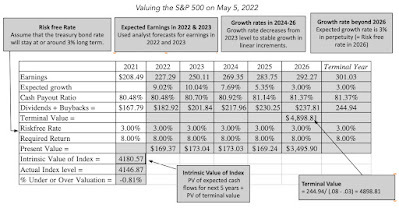 Download spreadsheet
The intrinsic value that you get for the index (4181) is almost spot on to the actual value, and that should not come as a surprise, since it reflects the consensus view on rates, earnings and risk premiums. However, there are wide divergences from the consensus on all three inputs and in the table below, I estimate the index values under these divergent viewpoints:
Download spreadsheet
The intrinsic value that you get for the index (4181) is almost spot on to the actual value, and that should not come as a surprise, since it reflects the consensus view on rates, earnings and risk premiums. However, there are wide divergences from the consensus on all three inputs and in the table below, I estimate the index values under these divergent viewpoints: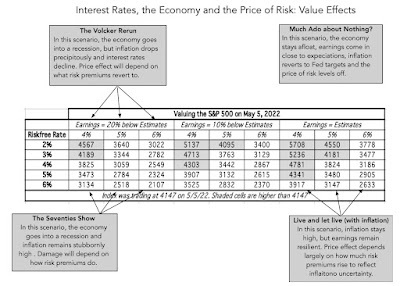
As you can see, the range of values is immense and they include scenarios ranging from the upbeat to the catastrophic. At one end of the spectrum, in the most benign scenario, which I will title Much Ado about Nothing, inflation turns out to be transient, fears of economic collapse are overstated and the equity risk premium reverts back towards historic norms, and the market looks under valued, perhaps even significantly so. At the other end, in perhaps the most malignant scenario, titled The Seventies Show, inflation continues to rise, even as the economy goes into recession and risk premiums spike, leading to a further correction of close to 50% in the market. In the middle, the Volcker rerun, Jerome Powell discovers his inner central banking self, cracks down on inflation and wins, but does so by pushing the company into a deep recession, making himself extremely unpopular with politicians up for election and the unemployed. There is a fourth possibility, where you Live and let live (with inflation), where we (as investors and consumers) accept a higher inflation world, with its costs and consequences, as the price to pay to keep the economy going. One of the costs that come with the last scenario is that inflation eats away at trust in not just currencies, but in all financial assets, and that investors will turn away from stocks and bonds. In the 1970s, the asset classes that benefited the most from this flight were gold and real estate, and the question is which asset classes will best play this role now, if inflation is here to stay. I do think that securitizing real estate has made it behave more like financial assets, and removed some of its power to hedge against inflation, but there may be segments (such as rental properties, where rent can be raised to match inflation) that retain their inflation fighting magic. Gold's history as a collectible gives it staying power, but the truth is that it is not big enough or productive enough as an investment class for us to all hold it. That, of course, brings us to cryptos, NFTs and other, more recent, entrants into the investment choice list. In theory, you could make the argument that these new investment choices will operate like gold, but you have two serious barriers to overcome. The first is that they have not been around for long, and that history is full of collectibles, from tulip bulbs to Beanie Babies to Pokemon cards, that people paid high prices for, but failed to hold their value. The second is that in the limited history that we have for cryptos and NFTs, they have behaved less like collectibles (holding or increasing in value, as stocks and bonds collapse) and more like very risky equities, going up when stocks go up, and dropping when stocks go down. In fact, higher and sustained inflation may be the acid test of whether there is any substance to the bitcoin as millennial gold story, and the results will make or break those holding cryptos for the financial apocalypse that they see coming.
In ConclusionThe inflation genie is out of the bottle, and if history is any guide, getting it back in is going to take time and create significant pain. It is the lesson that the US learned in the 1970s, and that other countries have learned or chosen to not learn from their own encounters with inflation. It is the reason that when inflation made itself visible in the early part of 2021, I argued that the Fed should take it seriously, and respond quickly, even if there existed the possibility that it was transient. Needless to say, the Fed and the administration chose a different path, one that can be described as whistling past the graveyard, not just ignoring the danger with happy talk, but also actively taking decisions that only exacerbated the danger. Needless to say, they now find themselves between a rock (more inflation) and a hard place (a recession), and while you may be tempted to say "I told you so", the truth is that we will all feel the pain.
YouTube Video
SpreadsheetsValue of the S&P 500 on May 5, 2022
Data
April 21, 2022
Elon's Twitter Play: Valuation and Corporate Governance Consequences
I am not a prolific user of social media platforms, completely inactive on Facebook and a casual lurker on LinkedIn, but I do use Twitter occasionally, and have done so for a long time, with my first tweet in April 2009, making me ancient by Twitter standards. That said, I tweet less than ten times a month and follow only three people (three of my four children) on the platform. I am also fascinated by Elon Musk, and even more so by his most prominent creation, Tesla, and I have valued and written about him and the company multiple times. When Musk made news a little over two weeks ago, with his announcement that he owned a major stake in Twitter, I could not stay away from the story, and what's happened since has only made it more interesting, as it casts light on just Musk and Twitter, but on broader issues of the social and economic value of social media platforms, corporate governance, investing and how politics has become part of almost every discussion.
The Twitter Story
To get a measure of Musk's bid for Twitter, you have to also understand the company's path to its current status. In this section, I will focus on the milestones in the company's history that shape it today, with an eye on how it may affect how this acquisition bid plays out.
Inception to IPO
Twitter was founded in 2006 by Jack Dorsey, Noah Glass, Biz Stone and Evan Williams, and its platform was launched later that year. It succeeded spectacularly in attracting people to its platform, hitting a 100 million users in 2012, and then doubling those numbers again by 2013, when it went public ,with an initial public offering. In a post on this blog on October 5, 2013, I valued Twitter, based on the numbers in its prospectus:
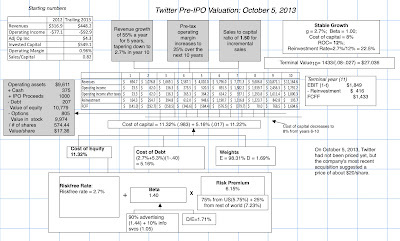 Spreadsheet with valuation
Spreadsheet with valuation
In keeping with my belief that every valuation tells a story, my IPO valuation of Twitter in October 2013 reflected my story for the company, as a platform with lots of users, that had not yet figured out how to monetize them, but would do so over time. My forecasted revenues for 2023 of $11.2 billion and predicted operating margin of 25% in that year reflected my optimistic take for the company, with substantial reinvestment (in acquisitions and technology) needed along the way (as seen in my reinvestment). A few weeks later, the offering price for Twitter's shares was set at $26, by its bankers, and the stock debuted on November 7, 2013, at $45. In the weeks after, that momentum continued to carry the stock upwards, with the price reaching $73.31 by December 26, 2013.
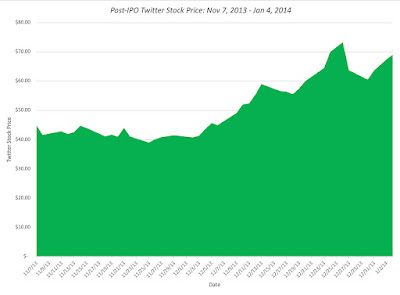
If the story had ended then, the Twitter story would have been hailed as a success, and Jack Dorsey as a visionary. But the story continues...
The Rise and Fall of Jack Dorsey
In the years since its IPO, the Twitter story has developed in ways that none of its founders and very few of its investors would have predicted. On some measures of user engagement and influence, it has performed better than expected, but in the operating numbers measuring its success as a business, it has lagged, and the market has responded accordingly
Users: Numbers and Engagement
In terms of user numbers, Twitter came into the markets as a success, with 240 million people on its platform in November 2013, at the time of its public offering. In the years since, those user numbers have grown, as can be seen in the chart below:
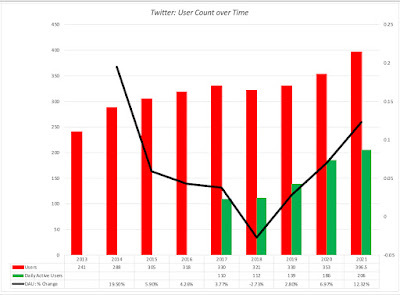
In keeping with disclosure practices at other user-based companies, in 2017, Twitter also started tracking and reporting the users who were most active on its platform, by looking at daily usage, and counting daily active users (DAU). While total user numbers have leveled off in recent years, albeit with a jump in 2021, the daily active user count has continued to climb.
Over the last decade, the company's platform, and the tweets that show up on it, became a ubiquitous part of news, culture and politics, as politicians used the platform to expand their reach and spread their ideas and celebrities built their personal brands around their followers. Looking at the list of the Twitter persona with the most followers provides some measure of its reach, with a mix of politicians (Barack Obama, Narendra Modi), musicians (Justin Bieber, Katy Perry, Taylor Swift, Ariana Grande), celebrities (Kim Kardashian) and sporting figures (Cristiano Ronaldo). Sprinkled in the list are brands/businesses (YouTube, CNN Breaking News), with millions of followers, though relatively few business people make the list, with Elon Musk being the exception. It is worth noting that many of the people on top follower list tweet rarely, and that behavior is mimicked by many of the users on the platform, many of whom never tweet. The bulk of the tweets on the platform are delivered by a subset of users, with the top 10% of users delivering 80% of the tweets.
While there are multiple reasons that Twitter users come to the platform, the demographics of its platform provides some clues, especially when contrasted with other social media platforms:
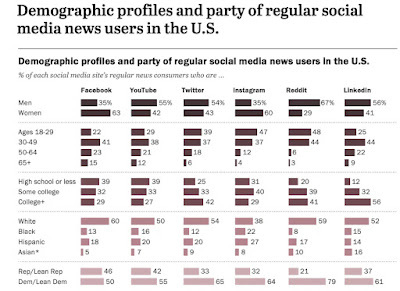 Pew Research
Pew ResearchTwitter's user base skews younger, more male, more educated and more liberal than the US population, and especially so, when compared with Facebook, which has the biggest user base.
Revenues, Profits and Stock Prices
As Twitter user base and influence have grown, there has been one area where it has conspicuously failed, and that is on business metrics. The company's revenues have come primarily from advertising (90%) and while these revenues have grown, they have not kept up with user engagement, as can be seen in the chart below:
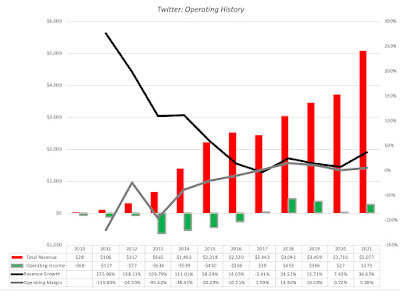
In the last few years, revenue growth has flattened, again with the exception of 2021, and while operating margins have finally turned positive in the last five years, there has been no sustained upward movement. To give a measure of Twitter's disappointing performance, note that the company's actual revenues in 2021 amounted to $5.1 billion, well below the $9.6 billion I estimated in 2021 (year 8 in my IPO valuation) as revenues in my IPO valuation of the company in November 2013, and its operating margin, even with generous assumptions on R&D, was 19.02% in 2021, still below my estimate of 19.76% in that year.
The disappointments on the operating metric front has played out in markets, where Twitter's stock price dropped to below IPO levels in 2016 and its performance has lagged its social media counterparts:
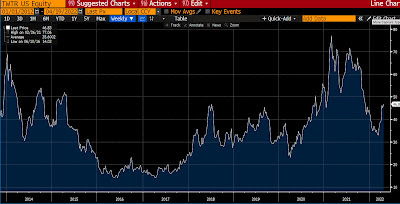 Source: Bloomberg
Source: BloombergIn fact, Twitter's stock prices did not breach their December 2013 high of $73.31 until February 26, 2021, when the stock peaked at $77.06, before dropping back to 2013 levels again by the end of the year. The company that provides the best contrast to Twitter is Snapchat, another company that I valued at the time of its IPO in February 2017 at $14.4 billion, with a value per share of $10.91. Like Twitter, Snapchat had a rousing debut in the market, rising 40% to hit $24.48 on its first trading day, before falling on hard times, as Instagram undercut its appeal. The stock dropped below $6 in 2019, before mounting a comeback in 2021. While Snap is a younger company than Twitter, a comparison of the operating metrics and user numbers yields interesting results:
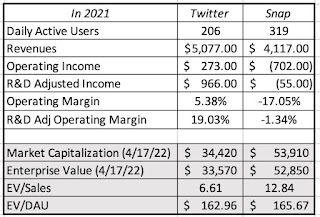
Looking at the 2021 numbers, Snap now has more daily active users than Twitter, but delivers less in revenues and is still losing money. That said, the market clearly either sees more value in Snap's story or has more confidence in Snap's management, since there is a wide gap in market capitalizations, with Snap trading at a premium of 60% over Twitter.
Corporate governance
While Twitter can be faulted on many of its actions leading into and after its IPO, there is one area where credit is due to the company. In a period when companies, especially in the tech sector, fixed the corporate governance game in favor of insiders and incumbents, by issuing shares with different voting classes, Twitter stuck to the more traditional model, with equal voting right shares. It is also worth noting that Twitter came into its IPO, with a history of bloodletting at the top, with Jack Dorsey, who led the company at the start, getting pushed aside by Evan Williams, his co-founder, before reclaiming his place at the top. In fact, at the time of its IPO, Twitter's CEO was Dick Costolo, but he was replaced by Dorsey again, a couple of years later. Dorsey's founder status gave him cover, but his ownership stake of the company was not overwhelming enough to stop opposition. As disappointment mounted at the company, the murmuring of discontent became louder among Twitter shareholders, especially since Jack divided his top executive duties across two companies, Twitter and Square, both of which demanded his undivided attention.
The corporate governance issues at Twitter came to a head in 2020, when Elliott Management, an activist hedge fund, purchased a billion dollars of Twitter stock, and demanded changes. While Dorsey was successful in fighting off their demands that he step down, he surprised investors and may company employees when he stepped down in November 2021, claiming that he was leaving of his own volition. That may be true, but it seemed clear that the relationship between Dorsey and his board of directors had ruptured, and that the departure might not have been completely voluntary. As a replacement, the board did stay within the firm in picking a successor, Parag Agrawal, who joined Twitter as a software engineer in 2011 and rose to become Chief Technology Officer in 2017.
The Musk Entree!
It is ironic that the threat to Twitter has come from Elon Musk, who has arguably used its platform to greater effect than perhaps anyone else on it. There are some Twitter personalities who have more followers than Musk, but most of them are either inactive or tweet pablum, but Musk has made Twitter his vehicle for selling both his corporate vision and his products, while engaging in distractions that sometimes frustrate his shareholders. While he has made veiled promises of alternative platforms for expression, it was a surprise to most when he announced on April 4, 2022, that he had acquired a 9.2% stake in the company. Stock prices initially soared on the announcement, but what has followed since has been one of the strangest corporate chronicles that I have ever witnessed, as you can see in the time line below:
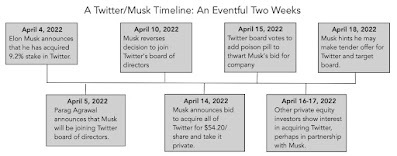
This post is being written on April 19, and the only thing that is predictable is that everything is unpredictable, at the moment, and that should come as no surprise, when Musk is involved.
The Value Arguments: Status Quo and Potential
While Musk's acquisition bid is anything but conventional, the gaming that it initiated on the part of Twitter, the target company, and Musk, the potential acquirer, was completely predictable. The company's initial response was that it was worth great deal more than Musk's offering price, and that Twitter shareholders would be receiving too little for their shares if they sold. Musk's response was that the market clearly did not believe that current management could deliver that higher value, and that he would be able to do much better with the platform.
Twitter's argument that Musk was lowballing value, by offering $54.20 per share for the company, and that the company was worth a lot more is not a novel one, and it is heard in almost every hostile acquisition, from target company management. That argument can sometimes be true, since markets can undervalue companies, but is it the case with Twitter? To answer that question, I valued Twitter on April 4, at about the time that Musk announced his 9.2% stake, updating my story to reflect a solid performance from the company in 2021, and with Parag Agrawal, its newly anointed CEO:
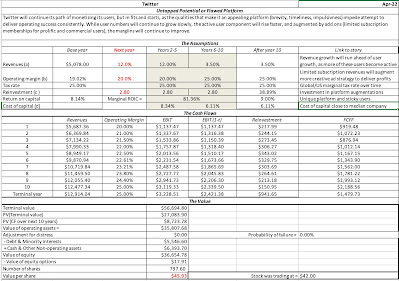 Spreadsheet with Twitter Status Quo Value
In my story, which I view as upbeat, given Twitter's inability to deliver on operating metrics in the last decade, I see continued growth in revenues, with revenues reaching almost $13 billion in 2033, and a continued increase in operating margins to 25%, not quite the levels you see at the dominant online advertising players (Facebook and Google), but about what you would expect for a successful, albeit secondary, online advertising platform. (Note that I am capitalizing R&D expenses to give the company healthier margins right now, to begin my valuation). The value per share that I obtained was about $46, $ 4 higher than the prevailing stock price, but below Musk's acquisition offer of $54.20.
Spreadsheet with Twitter Status Quo Value
In my story, which I view as upbeat, given Twitter's inability to deliver on operating metrics in the last decade, I see continued growth in revenues, with revenues reaching almost $13 billion in 2033, and a continued increase in operating margins to 25%, not quite the levels you see at the dominant online advertising players (Facebook and Google), but about what you would expect for a successful, albeit secondary, online advertising platform. (Note that I am capitalizing R&D expenses to give the company healthier margins right now, to begin my valuation). The value per share that I obtained was about $46, $ 4 higher than the prevailing stock price, but below Musk's acquisition offer of $54.20.To the critique that revenue growth could surprise and that margins could be higher, my answer is of course, and to incorporate the uncertainty in my inputs, I fell back on one of my favored devices for dealing with uncertainty, a Monte Carlo simulation. I picked three variables, the revenue growth over the next five years, the target operating margin and the initial cost of capital, to build distributions around, and the results of the simulation are below:
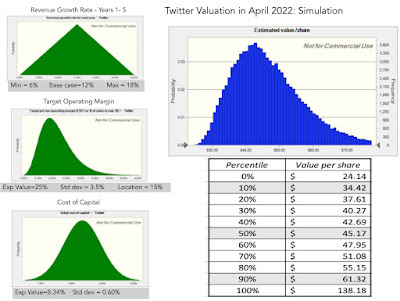 The median value in the simulation is $45.17, close to the base case valuation, but at least based on my estimates, Musk's offering price is at the 75th percentile of value. It is possible that the value could be higher but making that is not a particularly strong argument to make, if you are Twitter's board.
The median value in the simulation is $45.17, close to the base case valuation, but at least based on my estimates, Musk's offering price is at the 75th percentile of value. It is possible that the value could be higher but making that is not a particularly strong argument to make, if you are Twitter's board.Competing Views: The Fight for Twitter
As a company that has lived its entire life on the promise of potential, it should come as no surprise if that is where the next phase of this argument heads. In particular, Twitter's management will claim that the company's platform has the potential to deliver significantly more value, either by changing the business model (and including subscriptions and other revenue sources) or fine tuning the advertising model. On this count, Musk will agree with the argument that Twitter has untapped potential, but counter that he (and only he) can make the changes to Twitter's business model to deliver this potential. In short, investors will get to choose not only between competing visions for Twitter's future, but also who they trust to deliver those visions.
The problem that Twitter's management will face in mounting a case that Twitter is worth more, if it is run differently, is that they have been the custodians of the company for the last decade, and have been unable or unwilling to deliver these changes. Shareholders in Twitter will welcome management's willingness to consider alternative business models, but the timing makes it feel more like a deathbed conversion rather than a well thought through plan. Elon Musk's problem, on the Twitter deal, is a different one. If you think Jack Dorsey was stretching the limits of his time by running two companies, I am not sure how to characterize what Musk will be doing, if he acquires Twitter, since he does have a trillion dollar company to run, in Tesla, not to mention SpaceX, the Boring company and a host of other ventures. In addition, Musk's unpredictability makes it difficult to judge what his end game is, at least with Twitter, since he could do anything from selling his position tomorrow to bulldozing his way through a poison pill, taking Twitter down with him. I know that there are question of how Musk finance the deal and whether he can secure funding, but of all of the impediments to this takeover, those might be the easiest to overcome. The fact that Twitter's stock price has stayed stubbornly below Musk's offering price suggests that investors have their doubts about Musk's true intentions, and whether this deal will go through.
Alternate Endings
No matter what you think about Elon Musk and how his acquisition bid will play out, it is undeniable that he has put Twitter in play here, and that it is likely that the company that emerges from this episode will look different from the company that went into it. In particular, I see four possible outcomes for Twitter:
Status Quo: It is possible that Twitter wins this round with Musk, and that the poison pill adopted by the board is sufficient to get him to walk away from the deal, perhaps selling his holdings along the way. The existing management go back to their plans for incremental change that they have already put in motion, and hope that the payoffs of higher revenue growth and profitability will unlock share value. Musk takes Twitter private: Having spent more than a decade seeing Musk pull off what most market observers would view as impossible, I have learned not to underestimate the man. For Musk to succeed at this point, he has to be able to buy enough shares in a tender offer and/or convince other shareholders to put pressure on the board to remove the poison pill, and allow him to move forward with his plans. The odds are against success, but then again, this is Elon Musk.Independent, but with corporate governance changes: Even if Twitter is able to fend off Musk, the way that the company's management and board have handled the deal does not inspire confidence in their ability to run the company. In fact, having gone through five CEOs over Twitter's life, it is worth asking the question whether the dysfunction at the company lies with the board, and not just with the CEO. In this scenario, institutional investors will follow through by pushing for change in the company, translating into new board members and perhaps even a new CEO.Someone else acquires Twitter: There may be something to Musk's claim that the changes that are needed to make Twitter a functional business can only be made, if it is taken private. If so, it is the board may be willing to sell the company to someone other than Musk, albeit at a slightly higher price (if for no other reason than to save face). The fact that the buyer may be Silver Lake, a firm that Musk has connections with, or another private equity investor, whose plans for change are similar to Musk's, will mean that Elon Musk will have accomplished much of what he set out to do, without spending $43 billion dollars along the way or having to deal with the distractions that owning Twitter will bring to his other, more valuable, ventures.If I were to put these possibilities in terms of likelihood, I would put "staying independent with significant corporate governance changes" as most likely, followed by someone else acquiring Twitter, with the status quo and Musk succeeding getting the lowest odds.Political Markets?
In this discussion, I have deliberately stayed away from the elephant in the room, which is that this is , at its core, a political story, not a financial one. To see why, consider a simple test. If you tell me which side of the political divide you fall on, I am fairly certain that I will be able to guess whether you favor or oppose Musk's takeover bid. As with most things political, you will provide an alternate, more reasoned, argument for why you are for or opposed, but you are deluding yourself, and hypocrisy is rampant on both sides.
If you are opposed to the deal, and your argument is that billionaires should not control social media platforms, that outrage cannot be selective, and you should be just as upset about Jeff Bezos owning the Washington Post or a George Soros bid for Fox News. If it is Musk's personality that you feel is what makes him an unsuitable owner, I wonder whether we should be requiring full personality tests of the owners of other media companies.If you are for the deal, and it is because you want Twitter to be a bastion of free speech, it is worth remembering that every social media platform is involved in some degree of censoring, for legal reasons and self preservation. It should also be noted that while those disaffected with Twitter have attempted to build their own social media platforms, they still get far more mileage from their presence on Twitter than from their posts on alternate platforms, and the complaints about Twitter not being balanced seem to end up being on Twitter.The hand wringing from pundits about changes that may or may not be coming to Twitter, and the impact it will have on our collective consciousness, to be over wrought. In fact, some critics of Musk seem to have decided that Twitter, in its current form, is a national treasure that needs to be preserved or at least protected from money grubbing barbarians. I beg to differ. The brevity (of having to compress your thoughts into 280 characters) and timeliness of Twitter's platform has made it the place to go to get breaking news, but the notion that it is an educational platform shortchanges the meaning of learning, and the impulsiveness that it encourages from users is a recipe for tweeting remorse, or worse. I believe that while there are some who come to Twitter for news and witty repartee, many come to the platform for the same reasons that they slow down on highways to look at car crashes, i.e., to witness, and sometimes partake in, deranged arguments about trivial issues. Much as we like to complain about the ugliness and anger that we see on social media, it is exactly those forces that draw users to it, and arguing that Elon Musk will make it worse, misses the point that he symbolizes the strengths and weaknesses of the Twitter platform better than any other person walking the face of the earth.YouTube Video
SpreadsheetsValuation of Twitter on October 5, 2013 (for IPO)Valuation of Twitter on April 4, 2022 (after Elon takes stake)
March 28, 2022
ESG's Russia Test: Trial by Fire or Crash and Burn?
My views on ESG are not a secret. I believe that ESG is, at its core, a feel-good scam that is enriching consultants, measurement services and fund managers, while doing close to nothing for the businesses and investors it claims to help, and even less for society. That judgment may be harsh, but as the Russian hostilities in Ukraine shake up markets, the weakest links in the ESG chain are being exposed, and as the same old rationalizations and excuses get rolled out, I believe that a moment of reckoning is arriving for the concept. If you remain a true believer, I will leave it up to you to decide how much damage has been done to ESG, and what comes next.
The ESG Response To Russia
When Russian troops advanced into Ukraine in late February, the reverberations across markets were immediate. Stock, bond and commodity markets all reacted negatively, and at least initially, there was a flight to safety across the world. Since one of ESG's sales pitches has been that following it’s precepts would insulate companies and investors from the risks emanating from bad corporate behavior, both ESG advocates and critics have looked to its performance in this crisis, to get a measure of its worth. I am not an unbiased observer, but the reactions from ESG defenders to this crisis can be broadly categorized into three groups.
1. The Revisionists
In the last decade, as ESG has grown, I have been awed by the capacity of some of its advocates to attribute everything good that has happened in the history of humanity to ESG. If these ESG revisionists are to be believed, if companies had adopted ESG early enough, there would have been no banking crisis in 2008, and if investors had screened stocks for ESG quality, they would not have lost money in the corporate scandals and meltdowns of the last decade. In the last week of February 2022, in the immediate aftermath of this crisis, there were a few ESG supporters who argued that ESG-based investors were less exposed to the damage from the crisis. That was quickly exposed as untrue for three reasons:
ESG measurement services missed the Russia Effect: There is no evidence that Russia-based companies had lower ESG scores than companies without that exposure. In my last post, I looked at four Russian companies, Severstal, Sberbank, Yandex and Lukoil, all of which saw their values collapse in the last few weeks. When I checked their ESG rankings on Sustainalytics ranked each on February 23, 2022, each of them was ranked in the top quartile of their industry groups, though they all seem to have been downgraded since, with the benefit of hindsight. In a short piece in the Harvard Law Forum on Corporate Governance, Lev, Demeers, Hendrikse and Joos, highlight the absence of a Russia effect on ESG ratings with a simple comparison of ESG scores of companies with and without Russia exposure: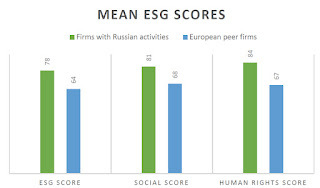
Unlike them, I will not argue that failing to foresee the Russian invasion of Ukraine is an ESG weakness, but it certainly cannot be presented as a strength.Following the ESG rulebook after the crisis has been a losing strategy: It is true that the emphasis on climate change that skews ESG scores lower for fossil fuel and mining companies would have kept you from investing in Lukoil and Gazprom, among other Russian commodity companies, but it would also have kept you from investing in other companies in these sectors, operating in the rest of the world. As I noted in my last post on Russia, that would have kept you out of the best performing sector since Russia invaded Ukraine. In short, if there is a lesson that this crisis has taught us, it is that treating fossil fuel producers as evil, when they produce much of the energy that we use, is delusional. ESG funds/lenders lost substantial amounts in Russia: Investment funds and lenders who have long touted their ESG credentials do not seem to have been less exposed than non-ESG funds, early reports notwithstanding. A Bloomberg Quint study of ESG funds uncovered that they had $8.3 billion invested in Russian equities on February 23, 2022, almost all of which was wiped out during the next few weeks. In fact, the saving grace for ESG funds has been the fact that Russia did not have a large investable market, for both ESG and non-ESG funds.In the weeks after the war, hundreds of US and European companies have announced that they were leaving Russia, and ESG advocates have pointed to this exodus as evidence that its practices are now mainstream. I would push back against the narrative that these companies were giving up lucrative businesses, because of their consciences:Small presence in Russia: In my last post, I noted that the Russian economy represents a sliver (about 2%) of the global economy. If you add the reality that Russia has a closed economy, with well established barriers to outsiders, most of the US companies pulling out of Russia are not giving up much business to begin with. In fact, for companies like Goldman Sachs, whose primary business in Russia came from acting as intermediaries between Russian businesses/investors and investors in the rest of the world, there is a question of whether any business was left to give up, after sanctions were put in place. The companies with the biggest presence in Russia are oil and commodity companies, primarily involved in joint ventures with Russian entities, where the pull out may be designed to preempt what would have been nationalization or expropriation in the future.Risk Surge and Economic Viability: In my last post, I noted the surge in Russia's default spread and country risk premium, making it one of the riskiest parts of the world to operate in, for any business. Many companies that invested in Russia, when it was lower-risk destination, have woken up to a new reality, where even if their Russian projects return to profitability, the returns that they can deliver are well below what they need to make to break even, given the risk. Put simply, exiting Russia makes economic sense for most companies, and it may be cloaked in morality, but it is easy to pick the moral path, when economics and morality converge.Suspension versus abandonment: It is telling that many companies that have larger interests in Russia, with perhaps the possibility that investing will become economically viable again, have suspended their Russian operations, rather than abandoning them. These companies will undoubtedly come under pressure from activists, who will try to shame them into leaving, but if that is the best that ESG can do, it is pitiful.For those who continue to insist that the corporate reaction to the Russian invasion is a sign of moral awakening at companies, I propose a thought experiment. If China had invaded Taiwan, do you think that companies would have been as quick to abandon their Chinese holdings and business? Do you think that investment funds would have been so quick to write off their Chinese holdings? On a more personal level, would you be willing to give up all things “Chinese”, as quickly as you were willing to give up drinking Russian vodka? They are hypothetical questions, but I think I know the answer.
2. The Expansionists
As the evidence has mounted that ESG, at least as constructed, failed to provide protection to companies and investors from the Russia fallout, there are a few in the ESG movement who have argued that the fix is to expand the definition and measurement of ESG to incorporate Russia-like risks. That is easier said than done, though, because as with all things ESG, those risks are in the eyes of the beholder. For some, it will mean bringing in the nature of governments into ESG measures, with companies in countries with authoritarian governments getting lower ESG scores than companies in countries with democratic governments. Even if you believe that expansion is defensible, and that considering political risk when valuing companies is prudent, it will mean that every ESG measurement service will have the unenviable task of assessing political freedom (or its absence) in a company's operating geographies, to evaluate its ESG score. Taking a bigger picture perspective, using the benefit of hindsight to keep expanding ESG to include the missed variables in each crisis will lead to measurement bloat, as it grows more tentacles and adds more dimensions. Ultimately, if ESG tries to measure everything, it ends up measuring and meaning nothing.
On a different note, the events of the recent weeks have also pointed to the elasticity of the ESG concept. In the weeks right after the war started, two Citigroup analysts suggested that companies making weapons be classified as good companies, as long as they were selling them to the “right” side of the conflict. While ESG advocates were dismissive, I think that what the Citigroup analysts were proposing is more in line with the true nature of ESG, an amorphous, anything goes concept that shifts shape and form, depending on who is defining it, and when.
3. The Utopians
There is a group within the ESG movement that has been unfazed by any critiques of ESG or evidence that it has not done what it set out to do. To these true believers, the problems with ESG come from it being misappropriated, mis-measured and misused, and in their view, ESG, done right, will always deliver its promised rewards. I call this group the "if only" chorus, since in their view, if only services measured ESG correctly, if only companies did not indulge in greenwashing, and, if only, ESG funds did not pick under performers, ESG would work at making the world a better place. I believe that their wait for this awakening will be long because:
ESG mis-measurement is endemic, not transient: Even ESG measurement services are willing to admit that the current ESG ratings for companies are flawed, but they all contend that better measurement is around the corner, premised on two assumptions. The first is that ESG disclosures will improve, as regulators force companies to reveal more about their environmental and social performance, and that this data will improve measurement. The second is that as ESG ages, we will develop consensus on what comprises goodness, and when that occurs, there will be a higher correlation across services. I don't believe that either assumption is realistic. Drawing on the experience with corporate governance and stock based compensation, both areas where the volume of disclosure has ballooned over the last two decades, I would argue that disclosure has actually created more distraction than clarity, and I don't see why ESG will be any different. As for converging on what comprises “good”, why in God’s name, in a world where everything is partisan, would you expect consensus to magically form in the investment community? In fact, if a consensus on measurement occurs across services on how to measure ESG, it will be driven more by marketing concerns (since the differences across ratings is getting in the way of selling the concept) than by learning.Greenwashing is an ESG feature, not a bug: There is probably no phenomenon on which there is more handwringing among ESG types than "greenwashing", where companies substitute "looking good" for "doing good". Those complaints, though, ignore an unpleasant truth, which is that greenwashing is exactly the outcome of making ESG a system of scores and rankings. I am willing to take a wager with any ESG true believer that the more ESG services and regulators try to crack down on greenwashing, the more ubiquitous and sophisticated it will become. The largest and most profitable companies will have the resources to game the system better, exacerbating biases that already exist in current ESG scores.ESG Investing underperformance is steady state, not a passing phase: For the last decade, ESG sales pitches were helped out by the seeming over performance of ESG-based investing, though almost all of the out performance could be attributed to ESG's tech focus and sector concentrations. As the market has shifted, and ESG-based strategies are now under performing, ESG investment fund managers are scrambling, trying to explain to clients why this is just a passing phase, and that good days are just around the corner. That is nonsense! In steady state, once the components of ESG that matter get priced in, ESG-constrained funds will deliver lower returns than funds that don't operate under those constraints. As I noted in one of my earlier posts on ESG, arguing that a constrained optimal can consistently beat an unconstrained optimal is sophistry, and the fact that some of the biggest names in the investment business have made these arguments tells us more about them than it does about ESG.ESG is not about actual change, but the perception of change: Over the last decade, ESG advocates have argued that even if following ESG precepts does not increase shareholder value or generate higher returns, it does good for society, by stopping bad practices. Some of ESG's biggest "wins" have been in the fossil fuel space, with Engine Number 1's success in forcing Exxon Mobil to adopt a smaller carbon footprint, being presented as a prime exhibit. Under investment pressure, there is no denying that publicly traded oil companies, primarily in the West, have scaled back their search for oil and gas, and sometimes scaled back and sold reserves. The key word here is "sold", since those reserves have often been bought by private equity investors, who have collectively invested more than a trillion dollars in fossil fuel reserves and development over the last decade. Is it any surprise then that despite all of the ESG wins, the world remains overwhelmingly dependent on fossil fuels? In fact, all that ESG activists have managed to do is move fossil fuel reserves from the hands of publicly traded oil companies in the US and Europe, who would feel pressured to develop those reserves responsibly, into the hands of people who will be far less scrupulous in their development. If this is what winning looks like in the ESG world, I would hate to see what constitutes losing!If you are an optimist on ESG, you may keep seeing light at the end of the tunnel, but the more this concept plays out, the more likely it is that the light you are seeing is that of a train bearing down on you.The Next Big Thing?
When a concept is as widely sold and bought into as ESG, it is unlikely to be abandoned in a hurry, no matter how much evidence accumulates that it does not work or that it has perverse consequences. In my experience, though, hollow concepts that promise the world and deliver little, eventually hit a tipping point, where even the most loyal adherents abandon them and move on. That moment will come for ESG, and if you are an ESG consultant, advisor or measurer, you will need something to replace its place, the next big thing, that you can sell as the answer to every question in business. Playing the role of a cynic, I will offer you a five step process that you can use to develop this "next big thing", which for generality, I will call “it”.
Give "it" a name: Give your next big thing a name, and pick one that sounds good, and if you want to add an aura of mystery, make it an acronym, with three letters seeming to do the trick, in most cases.Give "it" meaning and purpose: As you write the description of the word or acronym, make that description as fuzzy as possible, preferably throwing in the word "long term" and "good for the world" into it, for good measure. (See step 5 for why this works in your favor.)Use history to reverse engineer it’s components: Before you add specifics to your description, examine business and investing history, focusing on the most successful, and looking for characteristics that they share in common in terms. To round “it” out, you should also find failures and see what common features bind them together. Then incorporate these characteristics into your description, with the shared features of successful companies as your must-haves, and those of the failures are things to avoid.Use self-interest to sell "it": To get the business establishment behind you, draw on its powerful drivers, self interest, greed and self delusion. If you have done your job well in step 3, you will have no trouble gaining institutional support, since you have already primed the pump. Case writers and consultants should have no trouble finding supporting cases studies and anecdotal evidence, academic researchers will unearth statistical evidence that your concept works and investment fund managers will unearth its capacity to create "alpha" in past returns. Delay and deflect: If you get pushback from critics or those with evidence that is contradictory, attribute failures to growing pains and argue that what is needed is a doubling down of fidelity to the concept. Since you have provided no clear or even discernible targets, you can always move the goalposts or claim to have accomplished what you set out to, and thus not be held accountable. Finally, use the “goodness” shield, since that makes any questioning of your big idea seem small minded and mercenary.So, what will the next big thing be? I don't know for sure, but I am willing to make a guess, since so many ESG experts and advocates have slipped into already using it as an alternative. It is "sustainability", a word that can mean whatever you want it to mean. In its most benign form, I believe that it is just another word for "long term", though the only benefit of replacing one set of words with another is that it offers a chance for those using the new and updated word to state the obvious, claim the outrageous and charge the absurd. In its more malignant form, it becomes a way to try to keep corporations alive forever, a dreadful idea, where zombie and walking dead companies suck up capital and resources, and drag the rest of us down into the abyss with them.Conclusion
When I first wrote about ESG two years ago, I did so because I was skeptical of the unquestioning belief that people had in its success. I initially believed that it was a flawed concept that needed fixing , but after two years of interactions with people who claim to know the concept really well, but don't seem to be capable of making solid cases for it, and witnessing its takeover by well heeled entities with agendas, I am convinced that there will soon be room for only two types of people in the ESG space. The first will be the useful idiots, well meaning individuals who believe that they are advancing the cause of goodness, as they toil in the trenches of ESG measurement services, ESG arms of consulting firms and ESG investment funds. The second will be the feckless knaves, who know fully well the void behind the concept, but see an opportunity to make money. I know that those are not edifying choices, but I don't see any good ones, other than leaving the space completely. Good luck!
YouTube Video
Blog Posts on ESG
Sounding good or Doing good? A Skeptical Look at ESGESG: The Goodness Gravy Train rolls on (September 2021)March 19, 2022
Russia in Ukraine: Let Loose the Dogs of War!
As the world's attention is focused on the war in the Ukraine, it is the human toll, in death and injury, that should get our immediate attention, and you may find a focus on economics and markets to be callous. However, I am not a political expert, with solutions to offer that will bring the violence to an end, and I don't think that you have come here to read about my views on humanity. Consequently, I will concentrate this post on how this crisis is playing out in markets, and the effects it has had, so far, on businesses and investments, and whether these effects are likely to be transient or permanent.
The Lead In
To understand the market effects of the Russia-Ukraine conflict, we need to start with an assessment of the two countries, and their places in the global political, economic and market landscape, leading in. Russia was undoubtedly a military superpower, with its vast arsenal of nuclear weapons and army, but economically, it has never punched that weight. Ukraine, a part of the Soviet Union, has had its shares of ups and downs, and its economic footprint is even smaller. The pie chart below, provides a measure of the gross domestic product of Russia and Ukraine, relative to the rest of the world:
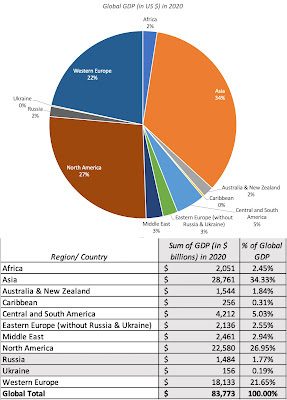
While Russia's share of the global economy is small, it does have a significant standing in the natural resource space, as a leading producer and exporter of oil/gas, coal and nickel, among other commodities. Ukraine is also primarily a natural resource producer, especially iron ore, albeit on a smaller scale.

Russia was also a leading exporter of these commodities, with a disproportionately large share of its oil and gas production going to Europe; in 2021, Russian gas accounted to 45% of EU gas imports.
The Market Reaction
As the rhetoric of war has heated up in the last few months, markets were wary about the possibility of war, but as Russian troops have advanced into the Ukraine, that wariness has turned to sell off across markets. In this section, I will begin by looking at the bond market effects and then move on to equities and other asset classes, starting by looking at the localized reaction (for Ukranian and Russian securities) and then the global ripple effects.
Bond Markets and Default Risk
In times of trouble, the first to panic are often lenders to the entities involved, and in today's markets, the extent of the reaction to country-level troubles can be captured in real time in the sovereign CDS (Credit Default Swap) markets. The graph below shows the sovereign spreads for Russia and Ukraine in the weeks leading up and including the conflict:

The sovereign CDS spread for Russia, which started the year at 1.70% soared above 25%, just after hostilities commenced, and were trading at 10.56% on March 16, after rumors that peace talks were underway brought them down. The sovereign CDS spread for the Ukraine started the year at 6.17% and climbed in the first few days of the crisis to more than 100% (effectively uninsurable) before settling in on March 16 at 28.62%. Even the ratings agencies, normally slow to act, have been moving promptly, with Moody's lowering Russia's rating from Ba2 to B3 on March 3, from B3 to Ca on March 6 and from Ca to C on March 8, and Ukraine's rating from B3 to Caa2 on March 4. Other ratings agencies have also taken similar actions. The worries about default have not stayed isolated to Russia and Ukraine, as ripple effects have shown up first in the countries that are geographically closest to the conflict (Eastern Europe) and more generally on sovereign CDS spreads in the rest of the world. The graph below looks at average spreads, by region, before and after the hostilities started:
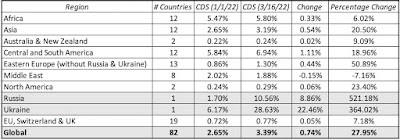 Change in Sovereign CDS, by RegionThere are no surprises in this table, with the effects on spreads being greatest for East European countries. Note, though, that while sovereign CDS spreads increased almost 51% between January 1, 2022 and March 16, 2022, in these countries, the overall riskiness of the region remains low, the average spread at 1.30%. The Middle East is the only region that saw a decrease in sovereign CDS spreads, as oil, the primary mechanism for monetization in this region, saw its price surge during the last few weeks. The Canadian sovereign CDS spread widened, but US and EU country spreads remained relatively stable. The increase in default spreads was not restricted to foreign markets, as fear also pushed up spreads in the corporate bond market. In the table below, I look at default spreads on bonds in different ratings, across US companies, on January 1, 2022 and March 16, 2022:
Change in Sovereign CDS, by RegionThere are no surprises in this table, with the effects on spreads being greatest for East European countries. Note, though, that while sovereign CDS spreads increased almost 51% between January 1, 2022 and March 16, 2022, in these countries, the overall riskiness of the region remains low, the average spread at 1.30%. The Middle East is the only region that saw a decrease in sovereign CDS spreads, as oil, the primary mechanism for monetization in this region, saw its price surge during the last few weeks. The Canadian sovereign CDS spread widened, but US and EU country spreads remained relatively stable. The increase in default spreads was not restricted to foreign markets, as fear also pushed up spreads in the corporate bond market. In the table below, I look at default spreads on bonds in different ratings, across US companies, on January 1, 2022 and March 16, 2022:
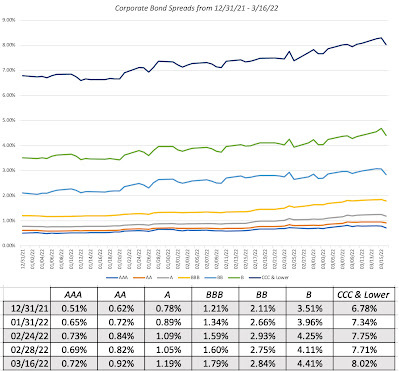
It is worth noting that corporate bond spreads, which were are at historic lows to start the year, were already starting to widen before Russia's military moved into the Ukraine on February 24, 2022, but the invasion has pushed the spreads further up at the lower ends of the default spectrum. The overriding message in all of this data is that Russia/Ukraine war has unleashed fears in the bond market, and once unleashed that fear has pushed up worries about default and default risk premia across the board.
Equity Markets and Equity Risk Premiums
Lenders may be the first to worry, when there is a crisis that puts their payments at risk, but equity investors are often with them, pushing down stock prices and pushing up equity risk premiums. Again, I will start with Russian and Ukranian equities, using country indices to capture the aggregate effect on these markets, from the invasion:
 Russia: RTX Russian Traded $ Index, Ukraine: Ukraine PFTS Index
Russia: RTX Russian Traded $ Index, Ukraine: Ukraine PFTS IndexNeither index is particularly representative, and currency effects contaminate both, but they tell the story of devastation in the two markets. In fact, since trading has been suspended on both indices, the extent of the damage is probably understated. To get a better sense of how Russian equities, in particular, have fared in the aftermath of the invasion, I looked at four higher profile Russian companies,:
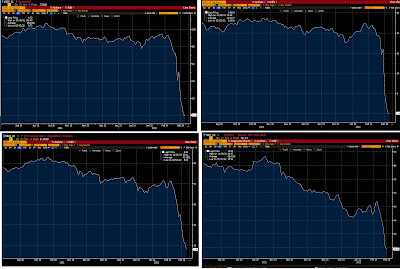
The four Russian companies that I picked are representative of the Russian economy: Lukoil is a stand-in for Russia's oil businesses, Sberbank is Russia's most dynamic bank, a part of almost every aspect of Russian financial services, Severstal is a global steel company with roots and a significant market share in Russia and Yandex is Russia's largest technology company. In addition to being traded on the MICEX, the Russian exchange, these companies all have listings in foreign markets (Yandex has a US listing and the other three are listed on the London Exchange). The collapse in stock prices has been calamitous, with each of the four stocks losing almost all of their value, and with trading suspended since the end of February, it is still unclear whether the trading will open up, and if so at what price.
 A knee-jerk contrarian strategy may indicate that you should be buying all these stocks, as soon as they open for trading, but a note of caution is needed. The price drop in these companies, especially severe at Sberbank, is not necessarily an indication that these companies will cease to exist, but that the Russian government may effectively nationalize them, leaving equity worthless. As Russian equities have imploded, the ripple effects again are being felt across the globe. The table below summarizes the market cap change, by region of the world:
A knee-jerk contrarian strategy may indicate that you should be buying all these stocks, as soon as they open for trading, but a note of caution is needed. The price drop in these companies, especially severe at Sberbank, is not necessarily an indication that these companies will cease to exist, but that the Russian government may effectively nationalize them, leaving equity worthless. As Russian equities have imploded, the ripple effects again are being felt across the globe. The table below summarizes the market cap change, by region of the world: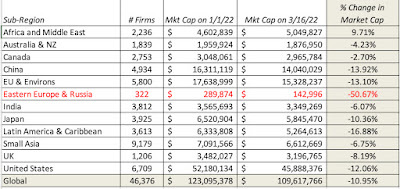 It is no surprise that Eastern Europe and Russia, which are in the eye of the hurricane, have seen the most damage to equities, but other than the Middle East, every other equity market in the world is down, with the US, EU and China shedding significant market capitalization. Slicing the data based on sector yields the following:
It is no surprise that Eastern Europe and Russia, which are in the eye of the hurricane, have seen the most damage to equities, but other than the Middle East, every other equity market in the world is down, with the US, EU and China shedding significant market capitalization. Slicing the data based on sector yields the following:
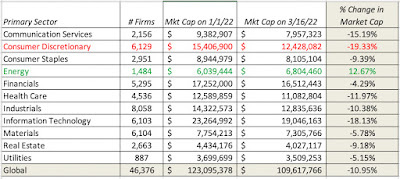 Against, there are no surprises, with energy being the only sector to post positive returns and with consumer discretionary and technology generating the most negative returns. Finally, I looked at firms based upon price to book ratios as of January 1, 2022, as a rough proxy for growth/maturity, and at net debt to EBITDA multiples, as a measure of indebtedness:
Against, there are no surprises, with energy being the only sector to post positive returns and with consumer discretionary and technology generating the most negative returns. Finally, I looked at firms based upon price to book ratios as of January 1, 2022, as a rough proxy for growth/maturity, and at net debt to EBITDA multiples, as a measure of indebtedness:
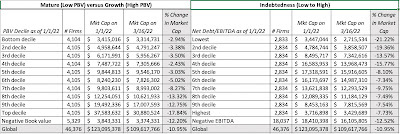
In this crisis, the conventional wisdom has held, at least so far, with mature companies holding their values better than growth companies. Since these mature companies tend to carry more debt, you see more indebted companies doing much better than less indebted companies. While the value crowd, bereft of victories for a long time, may be inclined to do a victory dance, it is worth noting that the same phenomenon occurred between February and March of 2020, at the start of the COVID crisis, but that growth companies quickly recouped their losses and finished ahead of mature companies by the end of 2020. In keeping with my belief that it is the price of risk that is changing during a crisis, causing contortions in prices, I estimated the implied equity risk premium for the S&P 500, by day, starting on January 1, 2022, going through March 16, 2022, in the graph below:
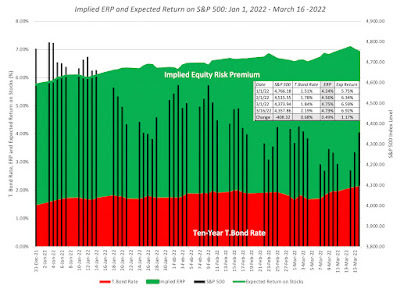 Download ERP, by day
Download ERP, by day
Note that equities were already under pressure in the weeks before the invasion, as inflation fears surfaced again, and then hostilities have put further pressure on them. The implied equity risk premium, which started the year at 4.24%, was at 4.73% by March 16, and the expected return on equity, which was close to an all-time low at 5.75% at the start of the year, was now up to 6.92%, still lower than historical norms, but closer to the numbers that we have seen in the last decade.
Flight to Safety and Collectibles As in any crisis, there was a rush to safety, accentuated by wealthy Russians trying to move their wealth to safe havens, with safety defined not just in terms of currency, but also in terms of being beyond the reach of US and European regulators and legislators. In the graph below, I start with two traditional havens for US investors, the US dollar and treasury bonds:
 Trade-weighted dollar & US 10-year T.Bond RateThe dollar has strengthened since February 23, with the trade weighted dollar rising about 3% in value, but the ten-year treasury bond, after an initial rise in prices (and drop in yields) has reversed course, perhaps as inflation concerns overwhelm safe haven benefits. I also looked at crisis investments, starting with gold, an asset that has held this status for centuries and contrasting it with bitcoin, millennial gold:
Trade-weighted dollar & US 10-year T.Bond RateThe dollar has strengthened since February 23, with the trade weighted dollar rising about 3% in value, but the ten-year treasury bond, after an initial rise in prices (and drop in yields) has reversed course, perhaps as inflation concerns overwhelm safe haven benefits. I also looked at crisis investments, starting with gold, an asset that has held this status for centuries and contrasting it with bitcoin, millennial gold:
Gold, which started the year at just above $1,800 an ounce, rose from $1,850 on February 23 to peak at $2,050/oz a few days ago, before dropping back below $2,000/oz on March 16. Bitcoin, which started the year at about $46,000, had a strong first half of November, also rose at the start of this crisis, but seems to have given back almost all of its gains. To the extent that crypto holdings may be more difficulties for authorities to trace and lay claim on, it will be interesting to see if you see a rise in the prices of crypto currencies as Russian wealth looks for sanctuary.
Economic Consequences
It is difficult to argue that people were taken by surprise by the events unfolding in the Ukraine, since the lead in has been long and well documented. It can be traced back to 2014, when Russia annexed Crimea, setting in motion a period of uncertainty and sanctions, and the global economy and Russia seemed to have weathered those challenges well. As this crisis plays out in financial markets, roiling the price of risk in both bond and equity markets, the other question that has to be asked is about the long term economic consequences of the crisis for the global economy.
Commodity Prices and Inflation Expectations
Given Russia's standing as a lead player in commodity markets, and its role in supplying oil and gas to Europe specifically, it should come as no surprise that the markets for the commodities that Russia produces in abundance has been the most impacted, at least in the short term:
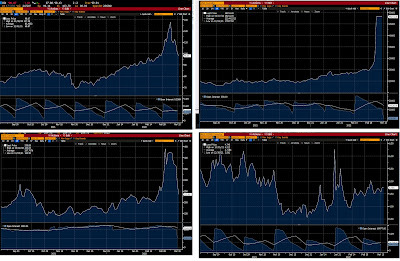 All four commodities saw their prices soar in the aftermath of February 23, with oil rising to $130 a barrel, before falling back below $100, and trading in the nickel market suspended on March 7, after prices rose about $100,000 a ton. Even as prices rose in the spot market, the futures market indicated that many participants believed that the price rise would be temporary, with futures prices closer to $80 a barrel, for a year ahead and two year ahead futures contracts.
All four commodities saw their prices soar in the aftermath of February 23, with oil rising to $130 a barrel, before falling back below $100, and trading in the nickel market suspended on March 7, after prices rose about $100,000 a ton. Even as prices rose in the spot market, the futures market indicated that many participants believed that the price rise would be temporary, with futures prices closer to $80 a barrel, for a year ahead and two year ahead futures contracts. In a market already concerned about expected inflation, the rise in commodity prices operated as fuel on fire, and pushed expectations higher. In the graph below, I list out two measures of expected inflation, one from a inflation expectations ETF (ProShares Inflation Expectation ETF) and the other from the Federal Reserve 5-year forward inflation measure, computed as the difference between treasury and TIPs rates.

Both measures indicate heightened concerns about future inflation, and these are undoubtedly also behind the increase in the US ten-year treasury bond rate from 1.51% to 2.19%, this year.
Consumer Confidence and Economic Growth
The question that hangs over not just markets but economic policy makers is how this crisis will affect global economic growth and prospects. It is too early to pass final judgment, but the early indications are that it has dented consumer confidence, as the latest reading from the University of Michigan consumer survey indicates:
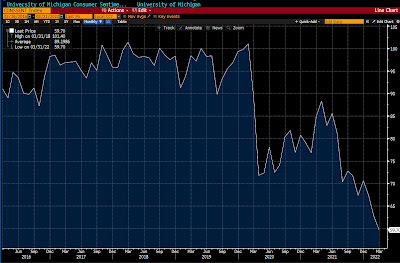 University of Michigan Consumer Sentiment
University of Michigan Consumer SentimentConsumer sentiment is now more negative than it was at any time during the COVID crisis in 2020, and if consumers pull back on purchases, especially of discretionary and durable goods, it will have a negative effect on the economy. While the contemporaneous numbers on the US economy on unemployment and production still look robust, worries about recession are rising, at least relative to where they were before the hostilities. The graph below looks at the median forecasts of recession probabilities for the US, on the left, and for the Eurozone, on the right (from Bloomberg):
 Median forecast probability of recession, US (left) and Eurozone (right)
Median forecast probability of recession, US (left) and Eurozone (right)As a result of the events of the last three weeks, forecasters have increased the probabilities of recessions from 15% to 20% for the US and from 17.5% to 25% for the Eurozone.
Investment Implications: Asset Classes, Geographies and Companies
The Russian invasion of Ukraine has undoubtedly increased uncertainty, affected prices for financial assets and commodities and exacerbated issues that were already roiling markets prior to the invasion. For investors trying to recapture their footing in the aftermath, there are multiple questions that need answers. The first is whether a radical shift in asset allocation is needed, given how these perturbations, across asset classes, geographies and sectors. The second is how the disparate market sell off, small in some segments and large in others, over the last few months has altered the investment potential in individual companies in these segments. On January 1, 2022, I valued the S&P 500, building in the expectation that the economy would stay strong for the year and that interest rates would rise over the course of time from the then prevailing value (1.51%) to 2.50% over five years, and arrived at a value of 4,320 for the index, about 10.3% lower than the traded value of 4766. While that was only ten weeks ago, the index has since shed 7.03% of its value, the T.Bond rate has risen to 2.19% and Russia's invasion of the Ukraine have increased commodity prices and the likelihood of a recession. I revisited my valuation of the index, with the updated values:
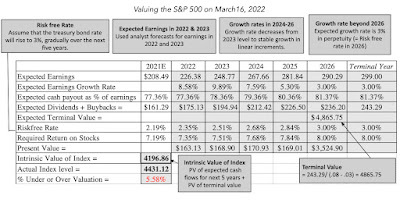 Spreadsheet to value the S&P 500
There are two things to note in this valuation. The first is that I have raised the target rate for the US T.Bond to 3%, reflecting both the increase that has already occurred this year, and concerns about how current events may be adding to expected inflation. The second is that I continue to use analyst estimates of earnings, and at least as of this week (with estimates from March 14, 2022), analysts do not seem to be lowering earnings to reflect recession concerns. That may either reflect their belief that this storm will pass without affecting the US economy significantly or a delay in incorporating real world concerns. If you open the spreadsheet, I offer you the option of adjusting expected earnings, if you believe analysts are being unrealistic in their forecasts. The net effect of the changes is that my estimated value of the index is now 4197, making the index over valued by 5.6% as of March 16, 2022. More generally, the question that investors face as they decide whether to reallocate their portfolios is whether the market has over or under reacted to events on the ground. If you are a knee-jerk contrarian, your default belief is that markets over react, and you would be buying into the most damaged asset classes, which would include US, European and Chinese stocks (worst performing geographies), and especially those in technology and consumer discretionary spaces (worst performing sectors), and selling those investments (energy companies and commodities like oil, that have benefited the most from the turmoil. If, on the other hand, you believe that investors are not fully incorporating the effects of the long term damage from this war, you would reverse the contrarian strategy, and buy the geographies and sectors that have benefited already and sell those that have been hurt. As an avowed non-market-timer, I think that both these strategies represent bludgeons in a market that needs scalpels. Rather than make broad sector or geographic bets, I would suggest making more focused bets on individual companies. In picking these companies, market corrections, painful though they have been, have opened up possibilities, for investors, though their stock picks will reflect their investment philosophies and their views on economic growth:Discounted Tech: During the course of 2022, markets have reassessed their pricing of tech stocks, and marked down their market capitalizations, for both older, and profitable tech and young, money-losing but high growth tech. A few weeks ago, I posted my valuation of the FANGAM stocks and noted that only one of them was under valued, at the prices prevailing then. In the last few days, every company on the list has dipped in price by enough to be at least fairly valued or even cheap. While there may be value in some young tech companies, any investments in these firms will be joint bets on the companies and a strong economy, and with the uncertainties about inflation and economic growth overhanging the market, I would be cautious.Safety First: If you have been spooked by market volatility and the Russian crisis, and believe that there is more volatility coming to the market in the rest of the year, your stock picks will reflect your fears. You are looking for companies with pricing power (to pass through inflation) and stable revenues, and in my view, and while you should start by looking in the conventional places (branded consumer products and food processing, pharmaceuticals), you should also take a look at some of the big names in technology.The Russia Play: For the true bargain hunters, the wipeout of market capitalization of Russian stocks (like Sberbank, Severstal, Lukoil and Yandex) will create temptation, but I would offer two notes of caution. The first is that you have to decide whether you can buy them in good conscience, and that is your judgment to make, not mine. The second is that corporate governance at Russian companies, even in their best days, is non-existent, and I do not know how this crisis will play out in the long term, at these companies. After all, your ownership stake in these companies is only as good as the legal structure backing it up, and in Russia, that your stake may be worthless, even if these companies recover. A less risky route would be to tag companies with significant exposure to Russia, such as Pepsi, McDonald's and Philip Morris, and evaluate whether the market is overreacting to that exposure. I have seen no evidence, so far, that this is the case, but that may change.There is one final sobering note to add to this discussion, and that relates to low probability, potentially catastrophic events, and how markets deal with them. There is a worst case scenario in the Russia-Ukraine war, that few of us are willing to openly consider, where the conflagration spreads beyond the Ukraine, and nuclear and chemical weapons come into play. While the probability of this scenario may be very low, it is not zero, and to be honest, there is no investing strategy that will protect you from that scenario, but market pricing will reflect that fear. If we escape that doomsday scenario, and come back to something resembling normalcy, markets will bounce back, and in hindsight, it will look like they over reacted in the first place, even if the risk assessments were right, at the time. Put simply, assuming that crises will always end well, and that markets will inevitably bounce back, just because that is what you have observed in your lifetime, can be dangerous.
Spreadsheet to value the S&P 500
There are two things to note in this valuation. The first is that I have raised the target rate for the US T.Bond to 3%, reflecting both the increase that has already occurred this year, and concerns about how current events may be adding to expected inflation. The second is that I continue to use analyst estimates of earnings, and at least as of this week (with estimates from March 14, 2022), analysts do not seem to be lowering earnings to reflect recession concerns. That may either reflect their belief that this storm will pass without affecting the US economy significantly or a delay in incorporating real world concerns. If you open the spreadsheet, I offer you the option of adjusting expected earnings, if you believe analysts are being unrealistic in their forecasts. The net effect of the changes is that my estimated value of the index is now 4197, making the index over valued by 5.6% as of March 16, 2022. More generally, the question that investors face as they decide whether to reallocate their portfolios is whether the market has over or under reacted to events on the ground. If you are a knee-jerk contrarian, your default belief is that markets over react, and you would be buying into the most damaged asset classes, which would include US, European and Chinese stocks (worst performing geographies), and especially those in technology and consumer discretionary spaces (worst performing sectors), and selling those investments (energy companies and commodities like oil, that have benefited the most from the turmoil. If, on the other hand, you believe that investors are not fully incorporating the effects of the long term damage from this war, you would reverse the contrarian strategy, and buy the geographies and sectors that have benefited already and sell those that have been hurt. As an avowed non-market-timer, I think that both these strategies represent bludgeons in a market that needs scalpels. Rather than make broad sector or geographic bets, I would suggest making more focused bets on individual companies. In picking these companies, market corrections, painful though they have been, have opened up possibilities, for investors, though their stock picks will reflect their investment philosophies and their views on economic growth:Discounted Tech: During the course of 2022, markets have reassessed their pricing of tech stocks, and marked down their market capitalizations, for both older, and profitable tech and young, money-losing but high growth tech. A few weeks ago, I posted my valuation of the FANGAM stocks and noted that only one of them was under valued, at the prices prevailing then. In the last few days, every company on the list has dipped in price by enough to be at least fairly valued or even cheap. While there may be value in some young tech companies, any investments in these firms will be joint bets on the companies and a strong economy, and with the uncertainties about inflation and economic growth overhanging the market, I would be cautious.Safety First: If you have been spooked by market volatility and the Russian crisis, and believe that there is more volatility coming to the market in the rest of the year, your stock picks will reflect your fears. You are looking for companies with pricing power (to pass through inflation) and stable revenues, and in my view, and while you should start by looking in the conventional places (branded consumer products and food processing, pharmaceuticals), you should also take a look at some of the big names in technology.The Russia Play: For the true bargain hunters, the wipeout of market capitalization of Russian stocks (like Sberbank, Severstal, Lukoil and Yandex) will create temptation, but I would offer two notes of caution. The first is that you have to decide whether you can buy them in good conscience, and that is your judgment to make, not mine. The second is that corporate governance at Russian companies, even in their best days, is non-existent, and I do not know how this crisis will play out in the long term, at these companies. After all, your ownership stake in these companies is only as good as the legal structure backing it up, and in Russia, that your stake may be worthless, even if these companies recover. A less risky route would be to tag companies with significant exposure to Russia, such as Pepsi, McDonald's and Philip Morris, and evaluate whether the market is overreacting to that exposure. I have seen no evidence, so far, that this is the case, but that may change.There is one final sobering note to add to this discussion, and that relates to low probability, potentially catastrophic events, and how markets deal with them. There is a worst case scenario in the Russia-Ukraine war, that few of us are willing to openly consider, where the conflagration spreads beyond the Ukraine, and nuclear and chemical weapons come into play. While the probability of this scenario may be very low, it is not zero, and to be honest, there is no investing strategy that will protect you from that scenario, but market pricing will reflect that fear. If we escape that doomsday scenario, and come back to something resembling normalcy, markets will bounce back, and in hindsight, it will look like they over reacted in the first place, even if the risk assessments were right, at the time. Put simply, assuming that crises will always end well, and that markets will inevitably bounce back, just because that is what you have observed in your lifetime, can be dangerous.YouTube Video
SpreadsheetsValuation of the S&P 500 on March 16, 2022DatasetsImplied ERP, by day, for S&P 500: January 1, 2022 - March 16, 2022Market Capitalization % Change, 1/1/22 - 3/16-22, by RegionMarket Capitalization % Change, 1/1/22 - 3/16-22, by Price to Book RatioMarket Capitalization % Change, 1/1/22 - 3/16-22, by SectorMarket Capitalization % Change, 1/1/22 - 3/16-22, by Net Debt/EBITDA
February 27, 2022
Data Update 5 for 2022: The Bottom Line!
Measuring Profitability The question of whether a company is making or losing money should be a simple one to answer, especially in an age where accounting statements are governed by a myriad of rules, and a legion of number-crunchers follow these rules to report profits generated by a firm. In practice, though, measuring profitability is anything but straightforward, as accountants have devised multiple measures of profitability, reserving discretion on how to compute each one, and many different ways of scaling these profits, for comparisons.
Accounting Profit Measures To understand the different measures of accounting profit, let us look at how each measure of profit is computed in an income statement. In the table below, I describe four different measures of earnings in an income statement, from gross profit, the most aggregated profit measure, to net profit, the earnings left for equity investors after taxes:
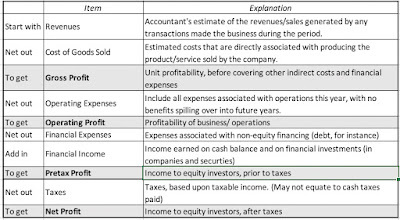
For non-financial service firms, the gross profit is a measure of what companies earn on the products/services that they sell, net of what it costs them to produce those products/services. Netting out other operating expenses, that are not directly tied to producing the goods and services (such as selling and G&A expenses), from gross profits, yields operating income. Income from financial holdings (including cash balances, investments in financial securities and minority holdings in other businesses) are added back, and interest expenses on debt are subtracted out to get to taxable income. After paying taxes on this income, the residual amount represents net income, the final measure of equity earnings, and the basis for computing earnings per share and other widely used measures of profitability used by equity investors. Looking across all publicly traded companies, listed globally, and aggregating revenues on all four measures of earnings (gross, operating, taxable, net), by sector, and aggregating the numbers yields the following:
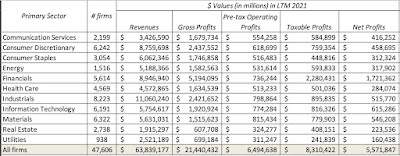 Note that for financial service firms, where debt is raw material (rather than a source of capital) and line between financial and operating assets is difficult to draw, the only measures of income that are relevant are taxable and net income. That said, about 31% of the net profits of all publicly traded firms listed globally in 2021 were generated by financial service firms; that percent is lower in the US and higher in emerging markets. The last few years have been eventful for all companies, with the COVID crisis and ensuing economic shut down causing pain for companies, with recovery coming in 2021, as the global economy opened up again. In the table below, I report the aggregated net income, by sector, from 2017 to 2021 (with the 2021 numbers representing last twelve month numbers, through September 2021):
Note that for financial service firms, where debt is raw material (rather than a source of capital) and line between financial and operating assets is difficult to draw, the only measures of income that are relevant are taxable and net income. That said, about 31% of the net profits of all publicly traded firms listed globally in 2021 were generated by financial service firms; that percent is lower in the US and higher in emerging markets. The last few years have been eventful for all companies, with the COVID crisis and ensuing economic shut down causing pain for companies, with recovery coming in 2021, as the global economy opened up again. In the table below, I report the aggregated net income, by sector, from 2017 to 2021 (with the 2021 numbers representing last twelve month numbers, through September 2021):
 It is clear that there was substantial damage done to earnings in 2020, across sectors, with energy, consumer discretionary and industrials showing the most negative effects; across all companies, aggregated earnings declined by 15.03% in 2020. In 2021, companies recovered entirely from the damage done in 2021, at least in the aggregate, with earnings in 2021 higher than 2019 earnings, by almost 33%. Real estate and utilities are the two sectors that have not come back fully from the COVID effect, but materials, technology and communication services are now reporting significantly higher earnings that before the shut down.
It is clear that there was substantial damage done to earnings in 2020, across sectors, with energy, consumer discretionary and industrials showing the most negative effects; across all companies, aggregated earnings declined by 15.03% in 2020. In 2021, companies recovered entirely from the damage done in 2021, at least in the aggregate, with earnings in 2021 higher than 2019 earnings, by almost 33%. Real estate and utilities are the two sectors that have not come back fully from the COVID effect, but materials, technology and communication services are now reporting significantly higher earnings that before the shut down.Profit Margins Comparing absolute profits across companies and across time can be difficult, since larger firms will generate more profits than smaller ones, all else held equal. To make comparisons, profits are scaled to common metrics, with revenues and book value of investment being the most common scalar. When profits are scaled to revenues, you get margins, and as with absolute earnings, margins come in various forms, as can be seen below:
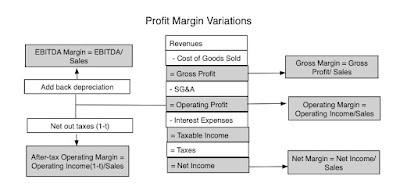 In addition to margins based upon income measures (gross, operating, after-tax operating and net), there are other margin variations, with EBITDA and after-tax operating margins coming into play. To get a sense of variation in margins across companies globally, we looked at the distribution of gross, operating and net margins in 2021:
In addition to margins based upon income measures (gross, operating, after-tax operating and net), there are other margin variations, with EBITDA and after-tax operating margins coming into play. To get a sense of variation in margins across companies globally, we looked at the distribution of gross, operating and net margins in 2021:
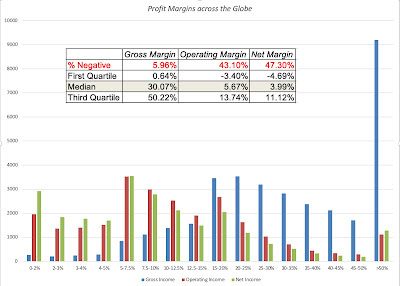 Earnings from LTM 2021, divided by revenues generated during that periodIn computing operating margins, I capitalized R&D for all companies, because R&D is a capital expense, rather than an operating expense, and extended the capitalization of operating leases to all global companies. (IFRS and GAAP now treat as leases as debt, but that is still not the case in many other markets that are not covered by either standard). The numbers yield interesting insights. First, note that while less than 6% of the 47,606 firms in the sample have negative gross margins, the number is significantly higher for operating margins (43.1%) and net margins (47.3%). Second, while it is no surprise that gross margins are significantly higher than operating and net margins, the magnitude of the difference is striking; the median gross margin across all global companies in 2021 is 30.07%, but it melts down to a median operating margin of 5.67% and a median net margins of less than 4%. These margins vary widely across companies, and in the table below, we report on the statistics across sectors:
Earnings from LTM 2021, divided by revenues generated during that periodIn computing operating margins, I capitalized R&D for all companies, because R&D is a capital expense, rather than an operating expense, and extended the capitalization of operating leases to all global companies. (IFRS and GAAP now treat as leases as debt, but that is still not the case in many other markets that are not covered by either standard). The numbers yield interesting insights. First, note that while less than 6% of the 47,606 firms in the sample have negative gross margins, the number is significantly higher for operating margins (43.1%) and net margins (47.3%). Second, while it is no surprise that gross margins are significantly higher than operating and net margins, the magnitude of the difference is striking; the median gross margin across all global companies in 2021 is 30.07%, but it melts down to a median operating margin of 5.67% and a median net margins of less than 4%. These margins vary widely across companies, and in the table below, we report on the statistics across sectors: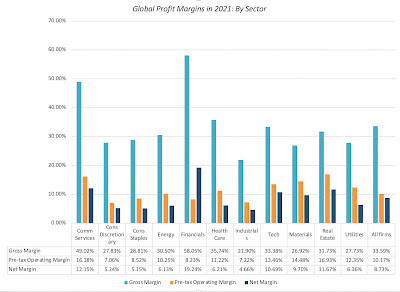
These sectors obviously are broad and each covers a range of industries. If you are interested in industry-level margins, you can find them at this link. In the graph below, I look at differences in margins across geographical regions:
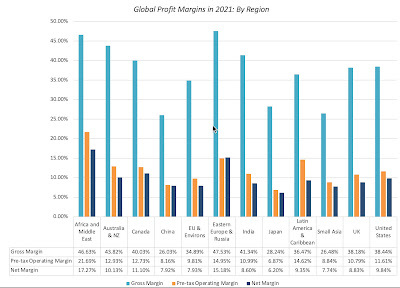
Eastern Europe (including Russia) and Africa contain some risky markets, but firms in those regions have the highest profit margins in the world. One reason is that domestic players in these markets face less foreign competition that companies in the rest of the world. The lowest profit margins in the world are in Asia, with gross margins less than 30% in China, Japan and South East Asia, but India remains an outlier, delivering higher margins. As companies from around the globe look to Asia for growth, the ensuing competition is pushing margins down there, relative to the rest of the world.
Returns on Invested Capital (or Equity)Scaling profits to capital invested in a company provides a different pathway to measuring profitability, with more consequential effects on value. This scaling can either be done from the perspective of just the equity investors in the company, with a return on equity, or from the perspective of all capital providers (debt and equity), with a return on invested capital:
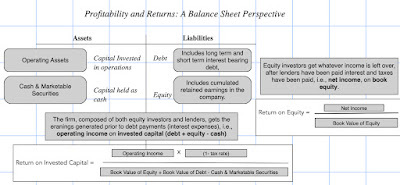
These measures are dependent on accounting estimates of not only earnings, but investment in the firm, in the form of book values of equity and invested capital, and that is their biggest weakness. To the extent that accountants mis-categorize expenses like leases and R&D, returns can be skewed, as can restructuring and one-time charges. With those caveats in place, and with my adjustments to earnings for R&D and lease capitalization, I computed the returns on equity and invested capital for all publicly traded firms at the start of 2022, using earnings in the last twelve months in the numerator and invested capital at the start of those twelve months in the denominator:
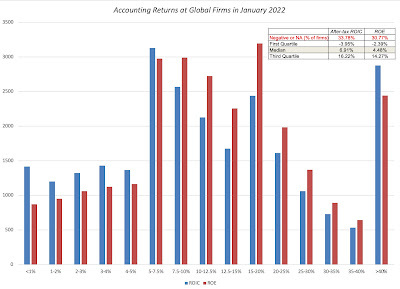
As with margins, almost a third of all firms have negative or missing accounting returns and the median return on equity, in US dollar terms, across all global firms is 4.48%, and the median return on invested capital, in US dollar terms, across firms is 6.91%. In my last post, I noted the decline in costs of capital for firms over time, noting that the median cost of capital at the start of 2022 is only 6.33%, across global firms, and argued that companies that demand double-digit hurdle rates risk being shut out of investments. That point is amplified by the accounting returns computations, since it looks like the actual returns earned by firms on their investments don't meet their own expectations.
ImplicationsIt is true that profitability measures, standing alone, give you only a snapshot of a company, in time, but used in context, they are conduits for almost every qualitative factor in investing, and put in a framework, a way of thinking of the value of growth and competitive landscapes.
Business Buzz WordsBuzzwords and catchy phrases has long been part of business, with consultants and experts offering them as recipes for corporate turnarounds, and companies using them to justify everything from acquisitions to significant business course changes. While their allure is understandable, their casual usage can lead to money ill-spent and catastrophic mistakes, and I have long argued that the best way to bring discipline to decision making is to convert these buzzwords into numbers that drive value. Put simply, every action, no matter how consequential it is framed as being, can affect value in one of three ways: by changing the growth trajectory for revenues, by altering the profitability of the business model or by modifying the risk in the business. Just to illustrate, I have a looked at some of widely used buzzwords with a link to profitability: table.tableizer-table { font-size: 12px; border: 1px solid #CCC; font-family: Arial, Helvetica, sans-serif; } .tableizer-table td { padding: 4px; margin: 3px; border: 1px solid #CCC; } .tableizer-table th { background-color: #104E8B; color: #FFF; font-weight: bold; } BuzzwordProfitability EffectReasoning Powerful Brand NameHigher operating profit margins, relative to peer groupBrand name allows you to charge higher price for the same products. Economies of scaleOperating margin improves as revenues increaseCosts grow at a slower rate than revenues Superior unit economicsHigh gross marginsExtra unit costs little to produce, relative to price. Strong competitive advantagesHigh return on capital, relative to peer groupBarriers to entry earn and sustain high returns Canny borrowerHigh return on equity, relative to return on capitalBenefits from difference between return on capital and after-tax cost of debt. Tax playerAfter-tax operating income is close to pre-tax operating incomeLower effective tax rate, across all income.
Note that I have steered away from the fuzzier phrases, such a "great management", which could mean everything or nothing, or "ESG", where goodness is not only in the eye of the beholder, but finding a link to anything that drives value resembles a wild goose chase.
A Life Cycle ViewIf you have been reading my posts for a while, you know that I find the corporate life cycle a useful device in explaining everything from what companies should focus on, in corporate finance, to the balance between stories and numbers, when investor value companies. Profit margins and returns also follow the life cycle, albeit with wide differences across firms:
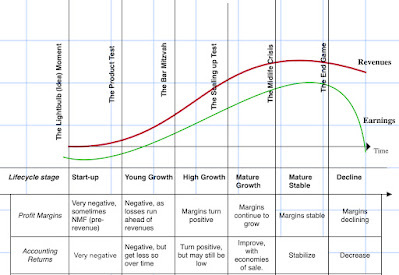
As you can see, young companies tend to be money-losers, and margins improve as companies make it through to maturity, before dropping as companies decline. Accounting returns follow a similar path, though they tend to peak a little later in the cycle, before declining in the last stages of the life cycle again. I am aware that there are many who disagree with my life cycle view of companies, but one way of testing whether it is a reasonable approximation of the real world is to look at the data. In the table below, I report on profit margins and accounting returns for firms, broken down by corporate age (measured from the founding year to 2021), across global companies at the start of 2022:
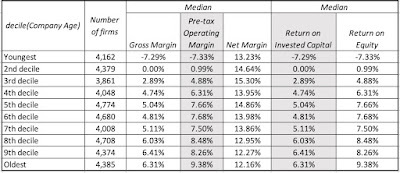 Corporate Age = Years since foundingIt is just one table, but the patterns of margins/returns matches a life cycle view, low for young companies, rising as companies mature, before declining as companies age.
Corporate Age = Years since foundingIt is just one table, but the patterns of margins/returns matches a life cycle view, low for young companies, rising as companies mature, before declining as companies age. The largest sector, in the US, in terms of market capitalization, is information technology and I have argued that tech companies age in "dog years", with compressed life cycles. The tech sector in the United States is composed of some companies like Apple, Microsoft, HP and Intel, which are ancient by tech company standards, and other companies like Uber, Palantir and Zoom, young and money-losing, that have gone public just in the last few years. In the table below, I break down US tech companies into age cohorts, based upon corporate age (measured from founding year), and looking at profitability measures across these cohorts, in the table below:
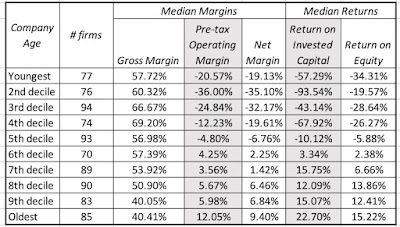 All companies in S&P technology sectorThis table illustrates the dangers of lumping all tech companies together as high growth or money losing, since older tech companies have become the profit engines in this market, delivering a combination of high margins and accounting returns that the stars of the twentieth century, mostly manufacturing and service businesses, would have envied. It also illustrates why some value investors who have an aversion to all tech companies, often for the most meaningless of reasons (such as not having a tangible book value), have lagged the market for close to two decades.
All companies in S&P technology sectorThis table illustrates the dangers of lumping all tech companies together as high growth or money losing, since older tech companies have become the profit engines in this market, delivering a combination of high margins and accounting returns that the stars of the twentieth century, mostly manufacturing and service businesses, would have envied. It also illustrates why some value investors who have an aversion to all tech companies, often for the most meaningless of reasons (such as not having a tangible book value), have lagged the market for close to two decades.The Value of Growth As investor tastes have shifted from earnings power to growth, there has been a tendency to put growth on a pedestal, and view it as an unalloyed good, but it is not. In fact, growth requires trade offs, where a company invests more back into itself in the near term, denying payouts (dividends or buybacks) to its investors, during that period, for higher earnings in the future. Not surprisingly, then, the net effect of growth will depend on how much is reinvested back, relative to what the company can harvest as future growth. While a full assessment of this value will require making explicit assumptions about growth and reinvestment, there is a short hand that is useful in making this assessment, and that is a comparison of the returns that a company makes on its investments to the cost of funding those investments. If you use accounting returns as a proxy for project returns, and the costs of equity and capital as measures of the costs of funding, you can compute excess returns to equity investors, by comparing return on equity to the cost of equity, and excess returns to all capital providers, by netting cost of capital from return on invested capital:
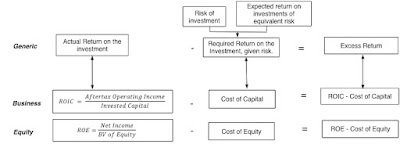
Using the accounting returns and costs of equity/capital that I computed for all publicly traded firms at the start of 2022, I looked at the distribution of excess return measures across companies in the graph below:
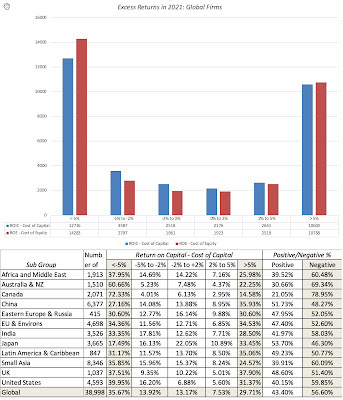 Close to 57% of firms globally earn returns lower than their funding costs, and while this may be temporary for some, it has become a permanent feature for many businesses. If you believe that the poor returns that you see in this table are a residue of COVID and economic short downs, I would suggest that you look at data that I have, on excess returns, going back almost a decade, and you will see similar results in the pre-COVID years. I will use this data to draw three broad conclusions:Low Hurdle Rate ≠ Positive Excess Returns: The notion that lower interest rates, and the resulting lower hurdle rates that companies face, has been a boon for business is clearly not supported by the facts. If anything, as rates have decreased over the last decade, and costs of capital for companies hit historic lows, companies are finding it more difficult to earn returns that exceed their costs of capital. Good and Bad Businesses: It is an undeniable truth that some businesses are easier to generate value in, than others, and that a bad business is one where most of the companies operating in it, no matter how well managed, have trouble earning their costs of capital. Using the excess returns estimated from 2021, I estimated the excess returns (ROIC - Cost of capital) in 94 industry groups, and the ten "best" and "worst" industries, in terms of median excess return, are listed below:
Close to 57% of firms globally earn returns lower than their funding costs, and while this may be temporary for some, it has become a permanent feature for many businesses. If you believe that the poor returns that you see in this table are a residue of COVID and economic short downs, I would suggest that you look at data that I have, on excess returns, going back almost a decade, and you will see similar results in the pre-COVID years. I will use this data to draw three broad conclusions:Low Hurdle Rate ≠ Positive Excess Returns: The notion that lower interest rates, and the resulting lower hurdle rates that companies face, has been a boon for business is clearly not supported by the facts. If anything, as rates have decreased over the last decade, and costs of capital for companies hit historic lows, companies are finding it more difficult to earn returns that exceed their costs of capital. Good and Bad Businesses: It is an undeniable truth that some businesses are easier to generate value in, than others, and that a bad business is one where most of the companies operating in it, no matter how well managed, have trouble earning their costs of capital. Using the excess returns estimated from 2021, I estimated the excess returns (ROIC - Cost of capital) in 94 industry groups, and the ten "best" and "worst" industries, in terms of median excess return, are listed below:
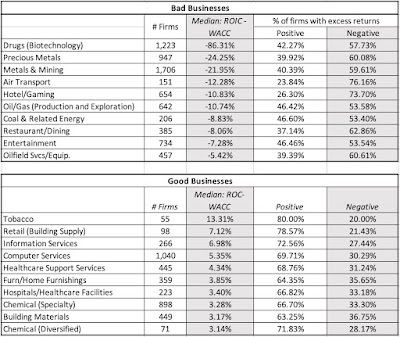 Excess Returns, by Industry (US, Global)If you look at the worst businesses, there are a couple that show up every year, like airlines and hotel/gaming, where COVID exacerbated problems that are long term and structural. The airline and hotel businesses are broken, and have been for a long time, and there is no easy fix in sight. Biotechnology companies can claim, with some justification, that their presence on the bad business list reflects the fact that many in the sector are young companies that are a breakthrough away from being blockbuster winners and that they will resemble the pharmaceutical business (which does earn positive excess returns), in maturity. I am sure that there will be ESG advocates who will claim credit for fossil fuel and mining businesses that show up in the worst business list, but not only will their rankings change quickly if oil and commodity prices rises, but the best business of all, in 2021, in terms of delivering excess returns, is the tobacco business, not a paragon of virtue. While the technology boom has created winners in information and computer services, building-related businesses (from materials to furnishings to retail) and chemical companies also seem to have found ways to deliver returns that exceed their costs. Disruption's Dark Side: Among the bad businesses, note the presence of entertainment, a historically good business that has seen its business model disrupted, by new entrants into the business. Netflix, in particular, has upended how entertainment gets made, distributed and consumed, and in the process, drained value from established players. While this is a phenomenon that has played out in business after business, over the last two decades, there are a couple of common themes that have emerged in the excess return data. Disruption, almost invariably, leads to lower returns for the status quo, i.e., the disrupted companies in the business, but disruptors often don't end up as beneficiaries. Consider the car business, where ride sharing has destroyed cab and traditional car service businesses, but Uber, Lyft, Didi, Grab and Ola all continue to lose money. Put bluntly, disruption is easy, but making money on disruption is difficult, and disruption creates lots of losers, but does not necessarily replace them with winners.If I were to sum up my findings, it would be to conclude that generating value from running a business has become more difficult, not less, in the last two decades and that while there are companies that seem to have found pathways to sustainable, high earnings, most companies are involved in trench warfare, fighting disruptors and facing significantly more macro economic risk in their operations.
Excess Returns, by Industry (US, Global)If you look at the worst businesses, there are a couple that show up every year, like airlines and hotel/gaming, where COVID exacerbated problems that are long term and structural. The airline and hotel businesses are broken, and have been for a long time, and there is no easy fix in sight. Biotechnology companies can claim, with some justification, that their presence on the bad business list reflects the fact that many in the sector are young companies that are a breakthrough away from being blockbuster winners and that they will resemble the pharmaceutical business (which does earn positive excess returns), in maturity. I am sure that there will be ESG advocates who will claim credit for fossil fuel and mining businesses that show up in the worst business list, but not only will their rankings change quickly if oil and commodity prices rises, but the best business of all, in 2021, in terms of delivering excess returns, is the tobacco business, not a paragon of virtue. While the technology boom has created winners in information and computer services, building-related businesses (from materials to furnishings to retail) and chemical companies also seem to have found ways to deliver returns that exceed their costs. Disruption's Dark Side: Among the bad businesses, note the presence of entertainment, a historically good business that has seen its business model disrupted, by new entrants into the business. Netflix, in particular, has upended how entertainment gets made, distributed and consumed, and in the process, drained value from established players. While this is a phenomenon that has played out in business after business, over the last two decades, there are a couple of common themes that have emerged in the excess return data. Disruption, almost invariably, leads to lower returns for the status quo, i.e., the disrupted companies in the business, but disruptors often don't end up as beneficiaries. Consider the car business, where ride sharing has destroyed cab and traditional car service businesses, but Uber, Lyft, Didi, Grab and Ola all continue to lose money. Put bluntly, disruption is easy, but making money on disruption is difficult, and disruption creates lots of losers, but does not necessarily replace them with winners.If I were to sum up my findings, it would be to conclude that generating value from running a business has become more difficult, not less, in the last two decades and that while there are companies that seem to have found pathways to sustainable, high earnings, most companies are involved in trench warfare, fighting disruptors and facing significantly more macro economic risk in their operations.YouTube Video
DatasetsProfit Margins, by Industry (US, Global, Emerging Markets, Europe, Japan, Australia & NZ)Return on Capital, by Industry (US, Global, Emerging Markets, Europe, Japan, Australia & NZ)Excess Returns, by Industry (US, Global, Emerging Markets, Europe, Japan, Australia & NZ)
February 12, 2022
Back to Earth or Temporary Setback? Revisiting the FANGAM Stocks
It has been a rocky year so far, in 2022, with worries about inflation competing with hopes about recovery for the market's attention. In the midst of all the action, to no one's surprise, have been six stocks (Facebook, Amazon, Netflix, Google, Apple and Microsoft or FANGAM) that have largely driven US equities for the last decade, roiling the market with their most recent earnings reports. Netflix and Facebook saw drops of 20% or more in market capitalization, following negative earnings reports, but Amazon and Google beat market expectations. In this post, I will be valuing each of these companies, both to assess whether to invest in them individually, and to examine whether there are lessons for the market in their price entrails.
My September 2020 Valuations
If you tally the winners and losers in the stock market sweepstakes between 2010 and 2019, it is undeniable that the decade belonged to the FANGAM stocks, as can be seen in the graph, where I chart the collective market cap of these six companies against the collective market cap of all US equities, and report on their percentage share:
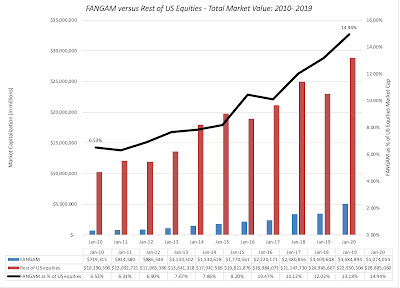
Over the course of the decade (2010-2019), the FANGAM stocks increased in collective market capitalization from $719 billion from $5.07 trillion, and their share of the overall equity value of all US stocks also surged from 6.5% to 14.9%. It is not hyperbole that without these stocks, the last decade would not have been a great one for US equities. Coming into 2020 in a position of strength, these companies got stronger, as COVID rocked economies and markets in 2020, which became the headline for one of my posts on COVID:
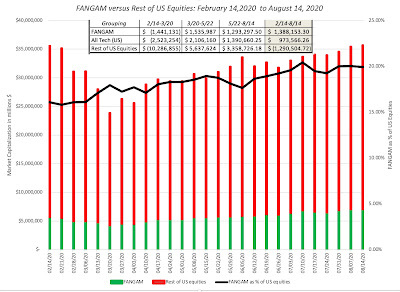 Between February 14, 2020 and August 14, 2020, as markets first collapsed and then recovered just as strongly, the FANGAM companies collectively added $1.39 trillion in market cap, accounting for all of the recovery in US stocks during that period. I have valued each of FANGAM multiple times in the past, but my most recent attempt to value each of them was in September 2020, as one of a series of posts highlighting how COVID was playing out in markets. I wanted to see if that surge, added on to the trillions in the market cap of US equities between 2010 and 2019, had left them in nosebleed territory, in terms of value. I must admit I was surprised by my own valuations, since, given the low riskfree rates prevailing at the time, only one stock (Apple) looked significant over valued. Of the rest, Microsoft and Amazon were over valued, albeit by modest most amounts, and Facebook was the most undervalued, and Netflix and Google were close to fairly valued.
Between February 14, 2020 and August 14, 2020, as markets first collapsed and then recovered just as strongly, the FANGAM companies collectively added $1.39 trillion in market cap, accounting for all of the recovery in US stocks during that period. I have valued each of FANGAM multiple times in the past, but my most recent attempt to value each of them was in September 2020, as one of a series of posts highlighting how COVID was playing out in markets. I wanted to see if that surge, added on to the trillions in the market cap of US equities between 2010 and 2019, had left them in nosebleed territory, in terms of value. I must admit I was surprised by my own valuations, since, given the low riskfree rates prevailing at the time, only one stock (Apple) looked significant over valued. Of the rest, Microsoft and Amazon were over valued, albeit by modest most amounts, and Facebook was the most undervalued, and Netflix and Google were close to fairly valued.
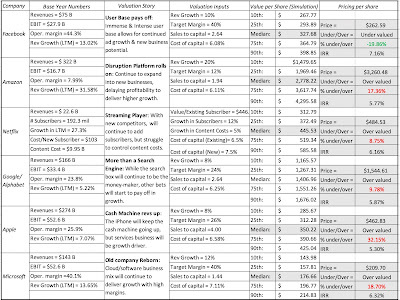 Read post, with links to valuations, from September 2020
At the end of that post, I disclosed that I owned Facebook, Microsoft and Apple, and that I would continue to hold the first two, and would sell my Apple shares. Clearly, much has happened since these valuations. The market has continued its march upwards, these companies have had multiple earnings reports and each of them has had newsworthy events occur.
Read post, with links to valuations, from September 2020
At the end of that post, I disclosed that I owned Facebook, Microsoft and Apple, and that I would continue to hold the first two, and would sell my Apple shares. Clearly, much has happened since these valuations. The market has continued its march upwards, these companies have had multiple earnings reports and each of them has had newsworthy events occur. Updating the Numbers
In the eighteen months since I valued these companies, much has happened, to the economy, to US equities collectively, and to these six companies, in specific. In the graph below, I report on the collective market capitalization of US equities, broken down into three groupings, the FANGAM stocks, all other US tech companies and the rest of the US equity market, from August 31, 2020 to February 9, 2022:
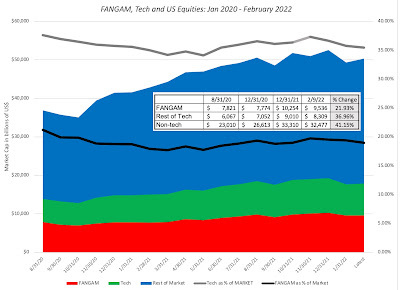 During the period, the collective market capitalization of FANGAM stocks increased by 21.9%, but they lagged the rest of the US tech sector (up 37%) and non-tech US equities (41.1%). For the first time in more than a decade, the FANGAM stocks are running behind the rest of the market. Breaking the FANGAM stocks into their constituent parts and charting their performance between August 31, 2020 and February 2022, here is what I get:
During the period, the collective market capitalization of FANGAM stocks increased by 21.9%, but they lagged the rest of the US tech sector (up 37%) and non-tech US equities (41.1%). For the first time in more than a decade, the FANGAM stocks are running behind the rest of the market. Breaking the FANGAM stocks into their constituent parts and charting their performance between August 31, 2020 and February 2022, here is what I get:
 During this period (8/31/20-2/9/22), three of the FANGAM stocks (Apple, Microsoft and Alphabet) were up strongly, and three (Amazon, Facebook, Netflix) were down. In summary, the FANGAM stocks were up collectively between August 31, 2020, and February 9, 2022, but they lagged the rest of the US equity market, with that underperformance isolated to Amazon, Facebook and Netflix.
During this period (8/31/20-2/9/22), three of the FANGAM stocks (Apple, Microsoft and Alphabet) were up strongly, and three (Amazon, Facebook, Netflix) were down. In summary, the FANGAM stocks were up collectively between August 31, 2020, and February 9, 2022, but they lagged the rest of the US equity market, with that underperformance isolated to Amazon, Facebook and Netflix. The Numbers
Since I last valued the FANGAM stocks in September 2020, there have been six quarterly earnings reports from each of these companies, and I report on two key operating measures, revenues and operating income, in the table below, for the last three fiscal years for each of the companies. (Note that four of these companies have calendar year-ends, and two have fiscal years that end mid-year. For the latter, I am reporting on the trailing 12-month numbers, to ensure that I have the calendar year numbers.)
 Looking at the percentage changes in revenues and operating income between 2019 and 2021 gives us a measure of how well each of these companies have navigated the currents of the last two years, and they seem to have turned the troubles to their advantage, posting strong compounded annual growth rates in revenues and operating income. These consolidated growth numbers, though, don't reflect the trend lines over the three years at these companies. Facebook and Netflix stumbled in their most recent earnings releases, losing more than a fifth of their market capitalization. With both companies, the user numbers were the basis for the negative surprises, with Facebook reporting its first drop in user number on a quarter-to-quarter basis as a public company and Netflix reporting underwhelming subscriber growth. Amazon and Google reported stronger than expected growth in both revenues and operating income, in the most recent quarter, and Microsoft and Apple delivered close to expected numbers.
Looking at the percentage changes in revenues and operating income between 2019 and 2021 gives us a measure of how well each of these companies have navigated the currents of the last two years, and they seem to have turned the troubles to their advantage, posting strong compounded annual growth rates in revenues and operating income. These consolidated growth numbers, though, don't reflect the trend lines over the three years at these companies. Facebook and Netflix stumbled in their most recent earnings releases, losing more than a fifth of their market capitalization. With both companies, the user numbers were the basis for the negative surprises, with Facebook reporting its first drop in user number on a quarter-to-quarter basis as a public company and Netflix reporting underwhelming subscriber growth. Amazon and Google reported stronger than expected growth in both revenues and operating income, in the most recent quarter, and Microsoft and Apple delivered close to expected numbers. The News
The FANGAM six, by virtue of their market capitalizations and their presence in our daily lives, have been also among the newsworthy of companies, and a significant portion of the news stories have are only mildly connected to current operating numbers. If I were to summarize the news about these companies in the last eighteen months:
The FANGAM Valuations: February 2022
In the trading game, where pricing is driven by mood and momentum, earnings reports and news stories are scanned for incremental news, information that ultimately will have little effect on value, but can move prices substantially. That explains the fixation with earnings per share expectations, and why seemingly trivial surprises, where a company beats or falls short of earnings expectations by a few cents can cause the market capitalization of a company to increase or decrease significantly. If you have been reading my posts, it should come as no surprise to you that I believe in intrinsic value, but I also believe that intrinsic value is driven by narrative. To me, the value effect of earnings reports and news stories comes from how they change (or don't change) the core narratives for companies. In keeping with that belief, I revisited my narratives for the FANGAM stocks, with the intent of revising these narratives, based upon what we have learned about these companies in the last two years:
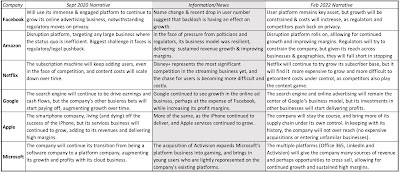
Converting these stories into numbers, I revalued the six companies. You can download the full valuations by clicking here (Facebook, Amazon, Netflix, Google, Apple, Microsoft), but the summary of my key assumptions and valuations are below:
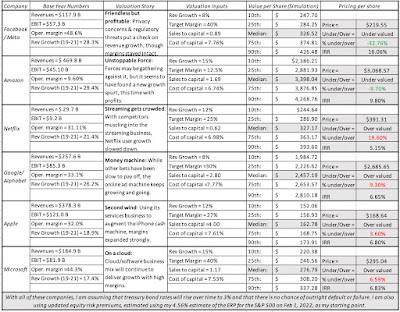 (Download full valuations of Facebook, Amazon, Netflix, Google, Apple, Microsoft)
(Download full valuations of Facebook, Amazon, Netflix, Google, Apple, Microsoft)At the risk of repeating some of what I have said before, here is what the valuations tell me about these companies, as investments.
Facebook looks the most under valued of the six companies, but one reason is that it seems to have lost its story script. For a decade whether you liked or hated the company, the story that drove its valuation was a simple one: a platform of billions of users, about whom Facebook knew a great deal, and they then used that knowledge to deliver focused advertising. In short, this is a company that has built its business on accessing and using private data, and the privacy backlash seems to have finally led the company to try to redefine itself, first by renaming itself (Meta), and then muddying the waters about its business model. I think that the company is still a profit-generating behemoth, with some of the highest operating margins in American business, but I think that until it finds a cohesive story line, the price recovery will be stilted.Netflix is the most overvalued company in the mix, even after its major price knock down, after the last earnings report. The company has upended the entertainment business and made everyone else in the business play the game their way, but it has always been on a hamster wheel, where its primary sales pitch to investors is its capacity to keep growing its subscriber base, and the only way it can keep doing this is by spending ever-increasing amounts of money of new content. The question of how the company would get off this hamster wheel has always been there, and now that user numbers are starting to slow, and new users are becoming more costly to acquire, the challenge of doing so has become larger. Microsoft and Apple have kept their heads low, as the rest of the FANGAM stocks have been buffeted by controversy and blowback. Apple seems to have found a way to be one of the good guys in the privacy battle, and in the process, intentionally or not, it has helped deliver punishment to others (like Facebook) in this rarefied group. For Microsoft, buying Activision advances them further towards becoming a premier platform business, and the company's diverse platforms (Office 365, LinkedIn and now Activision) offer the potential for growth and sustained high margins.Google surprised me the most, delivering high growth and increased margins, suggesting that Facebook’s problems are its own, and that Google continues to steamroll its online advertising competition. The other bets at Google continue to be cash-draining investments that deliver little in value, and after six years, I am not sure that they will be ever be big value creators, but that search box is the gift that keeps on giving.Amazon has, for much of its life, been a Field of Dreams company, offering investors a promise of revenues now, and if they wait patiently, profits in the future. For the first decades of its existence, all that investors saw was revenue growth, but margins remained slim to non-existent. In the last five years, Amazon’s margins have climbed and the company is solidifying its profit pathway, and while regulators and governments will try to rein it in, its mix of businesses and geographies will make it difficult to legislate against.I came into the analysis holding Microsoft, and I will continue to hold it, though it is mildly over valued. If I still had Apple in my portfolio, I would also hold it, but since I don’t own it now, I have to wait for a price dip, and when it comes, I will buy it. I used to own Facebook, and while I sold it on its name-change, I will be getting back into the stock, at current prices, notwithstanding its muddled story line and near-term troubles, simply because of its cheapness. On Amazon, a stock that I have bought and sold four times over the last twenty years, I am glad to add it back to my portfolio. As for Google, I have never held it, to my regret, and don't plan to add it on, at the current stock price. Finally, I just don’t like Netflix, even at depressed prices, since I believe that scaling down content costs, key to the company's future success, has become more difficult, not less, after the entry of Disney into the streaming wars. Needless to say, there is the broader question of the overall market, and how inflation will play out this year, but the answer to that question has a bigger effect on my overall asset allocation than on my judgment on whether to buy any of these stocks.YouTube Video
Valuation SpreadsheetsFacebook Valuation (February 2022)Amazon Valuation (February 2022)Netflix Valuation (February 2022)Google Valuation (February 2022)Apple Valuation (February 2022)Microsoft Valuation (February 2022)
February 8, 2022
Data Update 4 for 2022: Risk = Danger + Opportunity!
In the first few weeks of 2022, we have had repeated reminders from the market that risk never goes away for good, even in the most buoyant markets, and that when it returns, investors still seem to be surprised that it is there. Investors all talk about risk, but there seems to be little consensus on what it is, how it should be measured, and how it plays out in the short and long term. In this post, I will start with a working definition of riskt that we can get some degree of agreement about, and then look at multiple measures of risk, both at the company and country level. In closing, I will talk about some of the more dangerous delusions that undercut good risk taking.
What is risk?
In the four decades that I have been teaching finance, I have always started my discussion of risk with a Chinese symbols for crisis, as a combination of danger plus opportunity:

Over the decades, though, I have been corrected dozens of times on how the symbols should be written, with each correction being challenged by a new reader. That said, thinking about risk as a combination of danger and opportunity is both healthy and all encompassing. It also brings home some self-evident truths about risk that we all tend to forget:
Opportunity, without danger, is a delusion: If you seek out high returns (great opportunities), you have to be willing to live with risk (great danger). In fact, almost every investment scam in history, from the South Sea Bubble to Bernie Madoff, has offered investors the alluring combination of great opportunities with no or low danger, and induced by sweet talk, but made blind by greed, thousands have fallen prey. Danger, without opportunity, is foolhardy: In investing, taking on risk without an expectation of a reward is a road to ruin. If you are investing in a risky project or investment, your expected return should be higher to reflect that risk, even though fate may deliver actual returns that are worse than expected. Note that this common-sense statement leaves lots of details untouched, including how you measure risk and how you convert that risk measure into a higher "expected" or "required" return.It is uncertainty about outcomes, not expected outcomes, that comprise risk: In investing, we often make the mistake of assuming that risk comes from expected bad outcomes, when it is uncertainty about this expectation that drives risk. Let me use two illustrations to bring this home. In my last point on inflation, I noted that a currency with higher inflation can be expected to depreciate over time against a currency with lower inflation. That expected devaluation in the high-inflation currency is not risk, though, since it can and should be incorporated into your forecasts. It is uncertainty about whether and how much that devaluation will be, arising from shifting inflation expectations or market-induced noise, that is risk. In posts spread over many years, including this one, I have also argued against the notion that badly-managed firms are riskier than well-managed ones, and the reason is simple. If a firm is badly managed, and you expect it to remain badly managed, you can and should build in that expectation into your forecasts of that company's earnings and value. Thus, a badly managed firm, where you expect that to be the status quo, will be less risky than a well managed firm, where there is much more uncertainty about management turnover and quality in the future.Risk is in the future, not the past: Risk is always about the future, since the past has already revealed its secrets. That said, many of our perspectives about, and measures of, risk come from looking backwards, using the variability and outcomes of past data as an indicator of risk in the future. That may be unavoidable, but we have to be clear that this practice is built on the presumption that there have been no structural changes in the process being examined, and even if true, that the estimates that come from the past are noisy predictors of the future. Upside versus Downside Risk: If risk comes from actual outcomes being different from expectations, it is worth noting that those outcomes can come in better than expected (upside) or worse than expected. Since the entire basis of investing in risky assets is to benefit from the upside, it is downside risk that worries us, and in keeping with this perspective, there have to been attempts to derive risk measures that focus only on or more on downside risk. Thus, rather than use the variance in earnings or stock prices as a measure of risk, you compute the semi-variance, drawing on those periods where earnings and returns are less than expected. I think a more sensible path is to measure all risk, upside and downside, and think of good investing as a process of finding investments that have more upside risk than downside risk.As someone who works in, and teaches finance, I am grateful for what the discipline has done to advance the study of risk, but I would be remiss if I did not point out that it has come with some not-so-desirable side effects. One is the tunnel vision that comes from thinking of risk purely in terms of statistical measures, with standard deviation and variance leading the way. Risk is not an abstract statistical concept, but a feeling in the pit of your stomach that emerges when you helplessly watch your portfolio melting down, as markets move in the wrong direction. The other is the dangerous notion that measuring risk is the same as managing that risk and, in some cases, the even more insane view that it removes that risk.Risk and Hurdle Rates
In investing and corporate finance, we have no choice but to come up with measures of risk, flawed though they might be, that can be converted into numbers that drive decisions. In corporate finance, this takes the form of a hurdle rate, a minimum acceptable return on an investment, for it to be funded. In investing, it becomes a required return that you need to make an investment; you buy investments if you believe that you can make returns greater than their expected return and you sell investments if not. In this section, I will begin with a breakdown of risk's many components and use that structure to develop a framework for assessing the risk-adjusted required return on an investment.
The Components of Risk
In any investment, there are multiple sources of risk, and listing all of them in a list, with no organization, can be not only overwhelming but directionless. Once you have identified the risks that you face, it is useful to break that risk down into categories, on three dimensions: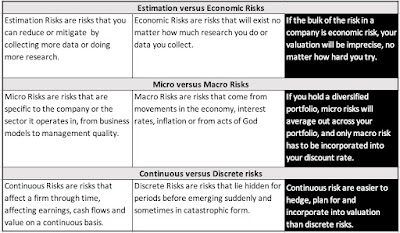 As you can see from this table, not all risk is created equal, and understanding which risks to incorporate into your required return, and which risks to ignore/pass through, is the first and perhaps the most important part of analyzing risk. While you will face almost every type of risk, no matter what company that you choose to value, the risks that you are most exposed to will vary across firms, and one way of looking at this variation is to look at firms through a corporate life cycle lens:
As you can see from this table, not all risk is created equal, and understanding which risks to incorporate into your required return, and which risks to ignore/pass through, is the first and perhaps the most important part of analyzing risk. While you will face almost every type of risk, no matter what company that you choose to value, the risks that you are most exposed to will vary across firms, and one way of looking at this variation is to look at firms through a corporate life cycle lens:
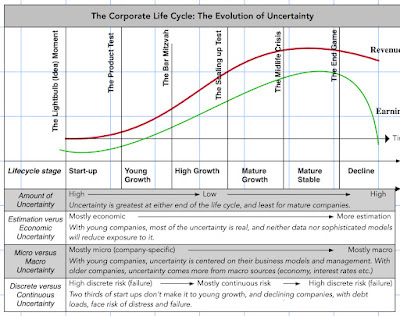 Note that you are more exposed to more risks, when you are looking at young companies, with growth potential, than when analyzing older, more mature firms, and that a greater proportion of risks at young companies are likely to be economic, micro and discrete risks. It is no wonder that investors and analysts who collect more and build bigger models, to value young companies, expecting that they will get better valuations, find frustrations instead. To get from these general risk categories into explicit risk measures and required returns, I adopt a simple structure (perhaps even simplistic), where I accept that I am a price taker when it comes to some risks (interest rates and risk premiums) and focus on the components of risk that companies can change through their choices on business, geography and debt load:
Note that you are more exposed to more risks, when you are looking at young companies, with growth potential, than when analyzing older, more mature firms, and that a greater proportion of risks at young companies are likely to be economic, micro and discrete risks. It is no wonder that investors and analysts who collect more and build bigger models, to value young companies, expecting that they will get better valuations, find frustrations instead. To get from these general risk categories into explicit risk measures and required returns, I adopt a simple structure (perhaps even simplistic), where I accept that I am a price taker when it comes to some risks (interest rates and risk premiums) and focus on the components of risk that companies can change through their choices on business, geography and debt load:
 Note that in this structure, which yields costs of equity for companies and required returns for equity investors, each component is designed to carry a single burden, with the risk free rate reflecting the currency that you analyzing the company in, the measure of relative risk capturing the risk of the company's business mix and debt load, and the equity risk premium incorporating the risk of the geographies of its operations.
Note that in this structure, which yields costs of equity for companies and required returns for equity investors, each component is designed to carry a single burden, with the risk free rate reflecting the currency that you analyzing the company in, the measure of relative risk capturing the risk of the company's business mix and debt load, and the equity risk premium incorporating the risk of the geographies of its operations.1. Relative Risk Measures
Before we embark on how to measure relative risk, where there can be substantial disagreement, let me start with a statement on which there should be agreement. Not all stocks are equally risky, and some stocks are more risky than others, and the objective of a relative risk measure is to capture that relative risk. The disagreements rise in how to measure this relative risk, and risk and return models in finance have tried, with varying degrees of success, to come up with this measure. At the risk of provoking the ire of those who dislike portfolio theory, the most widely model for risk, in practice, is the capital asset pricing model, and beta is the relative risk measure. Embedded in its usage is the assumption that the marginal investors in a stock, i.e., those large investors who set prices with their trading, are diversified, and that you can estimate the "non-diversifiable" risk in a stock, by regressing returns on a stock against a market index. I believe that a company's regression beta is an extremely noisy measure of its risk, and mistrust the betas reported on estimation services for that reason. I also believe that it is healthier to estimate the beta for a company by looking at the average of the regression betas of the companies in the sector that it operates in, and adjusting for the financial leverage choices of the company, since increasing dependence on debt also increases the relative risk of the company. As in prior years, I report industry-average betas, cleaned up for debt, at this link, for US companies, and you can sector-average beta for regional and global companies as well. At the start of 2022, the ten sectors (US) with the highest and lowest relative risk (unlettered betas), are shown below.
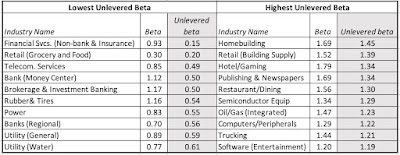 Download sector average betas (US, Global)Note the preponderance of financial service firms on the lowest risk ranks, but note also that almost all of them are substantial borrowers, and end up with levered risk levels close to average (one) or above. Technology and cyclical companies dominate raw highest risk rankings.
Download sector average betas (US, Global)Note the preponderance of financial service firms on the lowest risk ranks, but note also that almost all of them are substantial borrowers, and end up with levered risk levels close to average (one) or above. Technology and cyclical companies dominate raw highest risk rankings.2. Geographical Risk
Beta measure the macro risk exposure of the businesses that a company operates in, but they are blunt instruments, incapable of capturing either country risk (from operating in the riskiest parts of the world) or discrete risk (from default, nationalization or other events that truncate a company's life). For measuring country risk, I fall back on an approach that I have used for the last three decades to estimate equity risk premiums for countries, where I start with the equity risk premium for the US and then augment that number with a country risk premium, estimated from the default spread for the country:
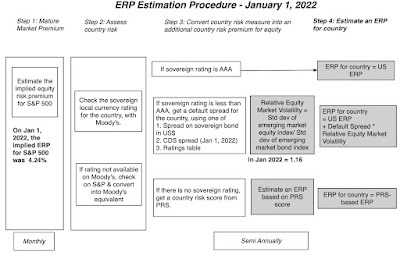
The equity risk premium for the US is the implied equity risk premium of 4.24%, the process of estimating which I described in an earlier data update post this year. The sovereign ratings for countries are obtained from Moody's and S&P, and the default spread for each ratings class comes from my estimates for the start of 2022. To illustrate, at the start of 2022, India was rated Baa3 by Moody's and the default spread (my estimate) for this rating was 1.87%. I scale that default spread up to reflect the higher volatility in stocks, relative to bonds, and I use 1.16, estimated from as the ratio of historical volatilities in S&P's emerging market stock to the volatility in an emerging bond indices. This approach yields a country risk premium of 2.18% for India, and an equity risk premium of 6.42%, to start 2022:
India's ERP at the start of 2022 = Mature Market ERP + Default Spread for India * Rel Vol of Equity
= 4.24% + 1.87% (1.16) = 6.42%
Using this approach to the rest of the world, here is what I get at the start of 2022:
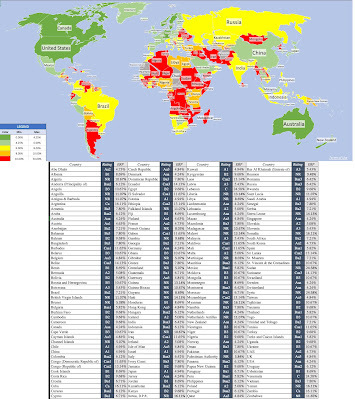 Download country equity risk premiums
It is worth emphasizing the equity risk premium for a company will come from where it operates in the world, not from its country of incorporation. Coca Cola, notwithstanding having its headquarters in Atlanta, has exposure to risk in multiple emerging markets, and its equity risk premium should reflect this exposure. By the same token, Embraer and TCS are global firms that happen to be incorporated in Brazil and India, respectively.
Download country equity risk premiums
It is worth emphasizing the equity risk premium for a company will come from where it operates in the world, not from its country of incorporation. Coca Cola, notwithstanding having its headquarters in Atlanta, has exposure to risk in multiple emerging markets, and its equity risk premium should reflect this exposure. By the same token, Embraer and TCS are global firms that happen to be incorporated in Brazil and India, respectively.3. Debt, Default Risk and Hurdle Rates
Almost all of the discussion so far has been about equity funding and its costs, but companies do raise funds from debt. While I will use a future post to talk about how debt levels changed in 2022, across the world, I want to talk about the cost of debt in this one. Specifically, the cost of debt for a company is the rate at which it can borrow money, long term, and today, and not the cost of the debt that is already on its books. The build up to a cost of debt is simple:

A company's default spread reflects concerns that lenders have about its capacity to meet its contractual commitments, and it clearly will be a function not only of the level and stability of its earnings, but even of the country in which it is incorporated.
As companies raise money from both debt and equity, they face an overall cost of funding, which will reflect how much of each component they use, and the resulting number is the cost of capital. The picture below illustrates the linkages between the costs of equity and debt, and how as you borrow more, the effects on cost of capital are unpredictable, pushing it down initially as you replace more expensive equity with cheaper debt, but then pushing it up as the negative effects of debt offset its benefits:
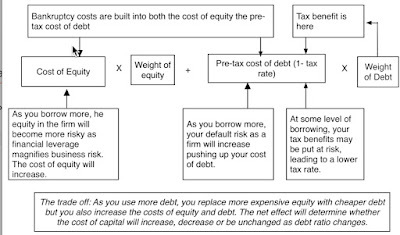
Since both the costs of debt and equity start with the riskfree rate, low risk free rates push down both costs. In my last two posts, I noted that the prices of risk have drifted down in markets, with both equity risk premiums and default spreads decreasing through 2021. It should come as no surprise then that at the start of 2022, companies across the globe were looking at costs of capital that are close to their lowest levels, in US $ terms, in decades.
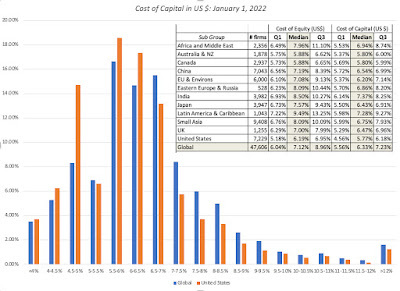
At the start of 2022, the median global company has a cost of capital of 6.33%, in US$ terms, and the median US company has a cost of capital of 5.77%. (To convert these values into other currencies, use the approach that I used in the last post, of adding differential inflation to the number).
Hurdle Rate Delusions
The two biggest forces that drive corporate financial and investor decision making are me-too-ism and inertia. The former (me-too-ism) leads companies to do what others in their peer group are doing, borrowing when they are, paying dividends because they do and even embarking on acquisitions to be part of the crowd. The latter (inertia) results in firms staying with policies and practices that worked for them in the past, on the presumption that they will continue to work in the future. Not surprisingly, both these forces play a role in how companies and investors set hurdle rates. Both individual investors and companies seem to operate under the delusion that hurdle rates should reflect what they want to make on investments, rather than what they need to make. The difference is illustrated every time an equity investor, in this market, posits that he or she will not buy shares in a company, unless he or she can make at least double digit returns, or a company, again in this market, contends that it uses a hurdle rate of 12% or 15%, in deciding whether to take projects. Individual investors who demand unrealistically high returns in a market that is priced to deliver 6-7% returns on stocks will end up holding cash, and many of them have been doing so for the bulk of the last decade. Companies that institute hurdle rates that are too high will be unable to find investments that can deliver higher returns, and will lose out to competitors who have more realistic hurdle rates. In short, companies and investors, demanding double digit returns, have to decide whether they want to remain delusional and be shut out of markets, or recalibrate their expectations to reflect the world we live in.
YouTube Video
Datasets
Equity Risk Premiums, by country - January 1, 2022Betas by Sector (US, Global, Emerging Markets, Europe, Japan)Costs of Capital by Sector (US, Global, Emerging Markets, Europe, Japan)Aswath Damodaran's Blog
- Aswath Damodaran's profile
- 725 followers



